

SUMMER 2023 | VOLUME 73, NO. 2
Annabelle Fowlkes, President


Susan Blount, Vice President
Carla McDonald, Vice President
John Flannery, Treasurer
Sarah Alger, Clerk
Nancy Abbey
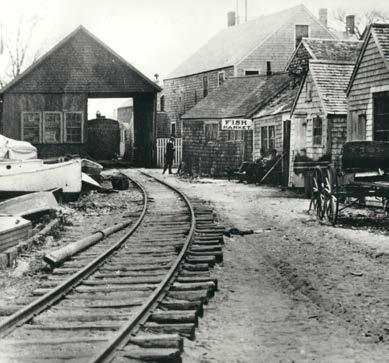
Patricia Anathan
Lucinda Ballard
Stacey Bewkes
Amanda Cross
Cam Gammill
Graham Goldsmith
Ashley Gosnell Mody
Robert Greenspon
Wendy Hudson
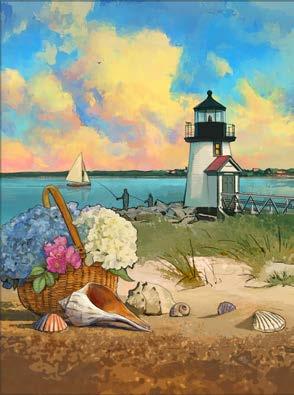
Kathryn Ketelsen, Friends of the NHA Representative
Valerie Paley
Marla Sanford
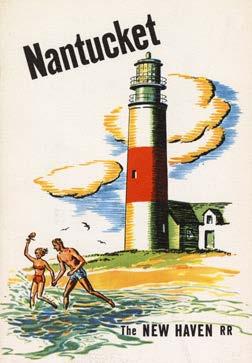
Denise Saul, Friends of the NHA Representative
Sara Schwartz
Janet Sherlund, Trustee Emerita
Carter Stewart
Melinda Sullivan
Michael Sweeney
Jason Tilroe
Ex Officio
Niles D. Parker, Gosnell Executive Director
Editor: Ashley Santos
Designer: Amanda Quintin Design
Board of Trustees 2023–24
all photos by nha staff unless otherwise noted.
SUMMER 2023 | VOLUME 73, NO. 2 4 Summer on Nantucket: A History of the Island Resort 12 The Beginnings of the Nantucket Railroad 20 Cottage Cities that never were.... 29 Modern Basket Maker: Kathleen Myers 30 News, Notes & Highlights 36 Summer Programs & Events 4 12 20 36 Table
Contents
of
Cover: Summer on Nantucket: A History of the Island Resort poster art by David Owens.
It’s Summer on Nantucket!
FROM THE BOARD PRESIDENT AND GOSNELL EXECUTIVE DIRECTOR



While the cool, rainy weather of late may not feel like it, summer is upon us. Our exhibitions have opened, the Whaling Museum, Hadwen House, and Historic Sites are welcoming visitors each day, and our team is hosting a number of community programs and events each week. In fact, the staff has been working incredibly hard on developing diverse programs and educational offerings which reach a broad mix of ages and learning styles-not just for this summer, but well into the fall and beyond. We are working on a five-year exhibition plan which we look forward to announcing soon. We thank you, as members of the NHA, for making all of this possible, and we hope to see you come through our doors for one of our many offerings, including an array of exclusive member events we have planned.
In this issue, we dive into some of the stories surrounding our featured exhibition, Summer on Nantucket: A History of the Island Resort, which has welcomed many complimentary reviews and recollections of nostalgic moments since it opened in May. Containing over 200 artifacts from our collection, it’s hard for any visitor who has a tie to the island to walk through without connecting their own summer memories to an object or a story on display. We highlight a special map exhibition on view at Hadwen House, exploring Cottage Cities that Never Were, which directly relates to the island resort economy and some of the conflicts we still face with construction development on the island today. Hadwen House also features another exceptional exhibition about Nantucket lightship baskets, tracing the origins of the iconic craft back from the 19th century to modern weavers. Two stand-out additions to this exhibit include recent acquisitions we highlight on the next page by one of the most prolific basket weavers from the island, Charles B. Ray.
We have also begun our exciting new partnership with the University of Pennsylvania, ICCROM, and ICR-ICC. Students have been meeting with Town officials, representatives from other non-profits, and scientists to explore our collection of historic properties. As we survey our properties, we seek to collect weather and climate data that can help us document the increasing rapidity of changes already occurring in the historic fabric of these buildings. As you visit our properties this summer, you may see some of the students at work. Please feel free to inquire about their projects.
In addition to visiting our exhibitions, we welcome visitors and residents to enjoy two new family program series this summer, including the Summer Sites Series, featuring history demonstrations, crafts, activities, and tours that bring our Historic Sites to life, as well as our Sea Shanties: Maritime Music Series, in partnership with Egan Maritime Institute, welcoming all to enjoy engaging and educational evenings of live maritime music performances outdoors. The NHA also looks forward to welcoming back Darius Coombs and members of the Mashpee Wampanoag tribe for a Wampanoag Day of celebration this August. These programs and more allow us to continue collaborating with organizations and creating diverse programs that reflect a broader understanding of Nantucket’s history.
We hope you will join in on some of the fun and history with us. Happy Summer!
Annabelle Fowlkes President, Board of Trustees
 Niles Parker Gosnell Executive Director
Niles Parker Gosnell Executive Director

Two baskets by Charles B. Ray (1798–1884)
The new Nantucket lightship basket exhibition, which opened at Hadwen House over Memorial Day weekend, features many important objects representing over 170 years of basket craft on Nantucket. Among the treasures are two examples of the work of Captain Charles B. Ray (1798–1884), one of the most prolific basket weavers on island after the Civil War. Much of Ray’s production comprised simple, open-topped baskets, but he also experimented. His typical work is represented by an oval basket, perhaps from the 1860s, that was recently donated to the collection by Ritchie Battle. His experimental work is exemplified by an oval-lidded basket formerly in the David Wood Collection and lent to the exhibition by Barbara and Alan Medaugh. This lidded basket is similar in many respects to the Friendship basket purses developed by José Reyes in the late 1940s and early 1950s and made ever since by many island weavers. The staves and weaver are very thin and finely worked. It has a wood swing handle, although this is set in a different direction to the way modern purse baskets are constructed. There are three inset mother-of-pearl decorations in the center of the cherrywood lid plaque. The middle inset is engraved with the initials “M.A.R.” The basket is believed to have been made in the 1870s as a gift for his daughter, Mary Abby Ray (1834–1920).

2 Historic Nantucket | Summer 2023
NOTABLE RECENT ACQUISITIONS
Oval basket, 1860s. Gift of Ritchie Battle, 2023.15.1.
Charles B. Ray was born on Nantucket. He made a career at sea and became a well-respected whaling master, commanding five whaling voyages to the Pacific between 1831 and 1851 (three from Dartmouth, one from New Bedford, and one from Nantucket). He retired from the sea to a farm on Nantucket and began making baskets sometime, perhaps, in the 1860s. The Inquirer & Mirror noted, “He devoted himself chiefly to agricultural labors, but of late years he has been noted for his skill in the manufacture of baskets. Of these, he has made many hundreds and usually found a ready sale for them, for many summer visitors were attracted by the beauty of the workmanship and became interested in the venerable workman.” The important island basket maker Clinton “Mitchy” Ray, who taught José Reyes, was Captain Ray’s grandson and pupil.



NHA.org | Nantucket Historical Association 3
Oval covered basket with handle, 1870s. Lent by Barbara and Alan Medaugh, IL2023.9.1.
By Michael R. Harrison, NHA Chief Curator and Obed Macy Research Chair

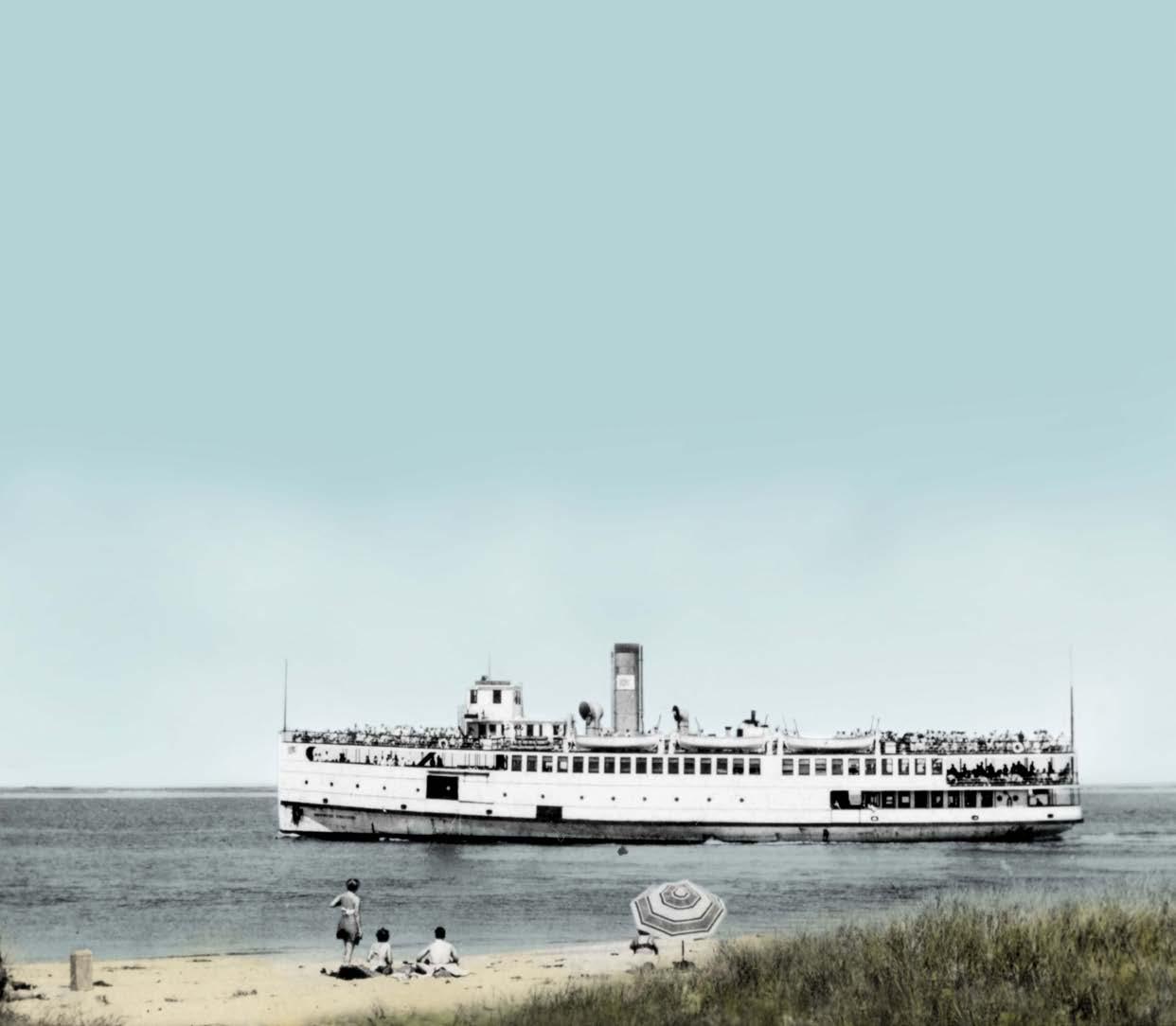
“ People are coming from every part of the country,” the Nantucket Inquirer declared in 1847, “to breathe our pure and invigorating air, to enjoy our unequalled ocean scenery, to bathe, walk, ride . . . in a word, to enjoy themselves.” For more than 170 years, people have come to Nantucket in the summer to enjoy the beaches and soak in the atmosphere of the historic town. To many, the island’s rose-covered cottages, ocean breezes, and bucolic natural spaces make it an ideal escape from mainland life—“far at sea, an anchor of rest,” as one visitor dubbed it in 1880.

SSummer on Nantucket: A History of the Island Resort is the primary exhibition of the 2023 season at the Nantucket Whaling Museum. Museum staff have filled the McCausland Gallery with more than two hundred objects from the association’s collections representing why people visit Nantucket in the summer, what they do here, where they stay, and what challenges the island has had to tackle over time as a result of the island resort’s success. The exhibition highlights that the development of a resort economy on Nantucket after the collapse of whaling was a conscious choice made by local people. It also stresses that year-round residents, seasonal workers, and skilled contractors are as much a part of the summer story as seasonal residents, vacationers, and daytrippers.
The following pages are adapted from the script for the exhibition, presenting aspects of the summer story as told in the gallery.
NHA.org | Nantucket Historical Association 5 SUMMER ON NANTUCKET
Two women relax on the dunes above Galley Beach, August 1957. Photograph by Toni Frissell for Sports Illustrated, Library of Congress Prints and Photographs Division, LC-DIG-tofr-40715.
THE RESORT ECONOMY
Nantucket ceased to be a competitive whaling port in the 1840s and 1850s, due to its shallow harbor entrance and the development of railroads on the mainland. As the whaling industry collapsed, people and investment moved away. The residents who stayed sought new ways to survive. Farming, sheep-raising, and cranberry-harvesting increased. The disused Friends meeting house on Main Street became a straw-hat factory in 1853, and investors established a mackerel fishing fleet in 1864. None of these ventures filled the void. Only the gradual and intentional development of the island as a summer resort proved capable of generating meaningful economic impact.
Nantucketers developed the island’s first purpose-built amenities for tourists in the late 1840s. In the late 1860s, they began concerted efforts to advertise Nantucket as an ideal “watering place.” “Why shouldn’t Nantucket be rendered as attractive a place of summer resort as possible,” a correspondent wrote to the Nantucket Weekly Mirror in May 1864, “especially if the means of attraction will pay?” A rush of hotel building and land speculation followed in the 1870s and 1880s, setting in motion an economy based on real-estate sales, land development, and construction. Today, nearly all of the island’s economic activity, including house sales,
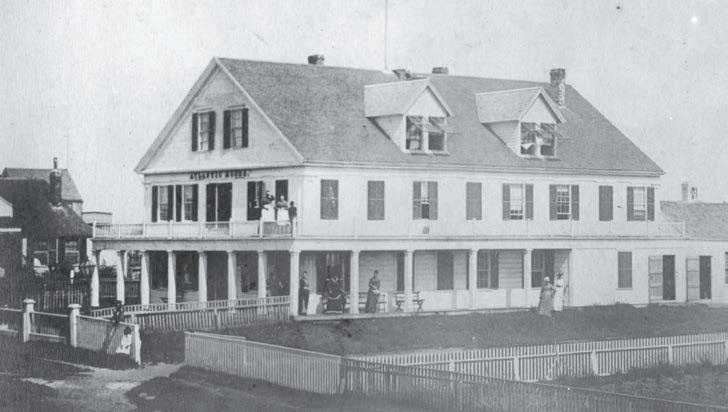
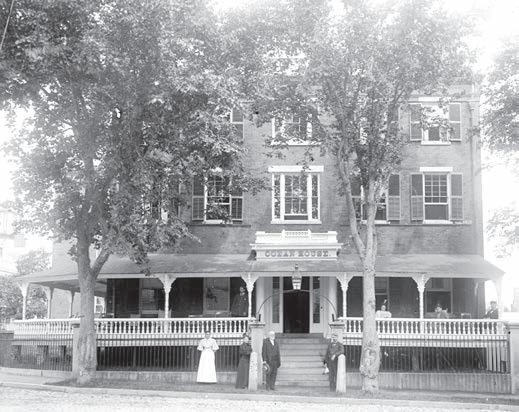
building, landscaping, and hospitality services—even fishing for the bay scallop—is driven by the needs and demands of the summer resort.
Getting to and from Nantucket has always been one of the charms, and hassles, of an island summer holiday. Intense lobbying by local businesses for “Two Boats a Day!” in summertime boosted island tourism starting in 1874; three boats a day did not start until the 1930s. Today, the traditional and high-speed ferries combined make 26 sailings a day in summer and carry about 67,000 automobiles, 50,000 trucks, and nearly one million passengers a year. Only one traveler in five comes to Nantucket by airplane.
Today, Nantucket has about 14,000 year-round inhabitants. During the summer months, seasonal residents, short-stay vacationers, and seasonal workers typically swell the population to more than 40,000; in 2022, the summer population topped 65,000.
6 Historic Nantucket | Summer 2023
The first two tourist hotels on Nantucket: Ocean House, converted from Jared Coffin’s Broad Street mansion by the Nantucket Steamship Company in 1847, and Atlantic House, which served visitors to ’Sconset from 1848 to 1921. GPN2661, A44-62.
"For 150 years, Nantucket has been advertised as a place for swimming, sailing, fishing, and nature-walking."
MUST SEE, MUST DO
In the 1882 guidebook The Island of Nantucket: What It Was and What It Is, Edward Godfrey praised the island’s attractions, as he saw them: “The fishing and the gunning; the rowing and sailing; the bathing, the botanizing, the geologizing; the moonlight rambles on the beach, and the love-making—it is really true that hearts are won and lost on Nantucket.” Since the 1840s, Nantucket’s promoters have hoped to win hearts by extolled the island’s sea air, clean beaches, and historic atmosphere. Countless brochures, guidebooks, articles, and stories from happy visitors have convinced more and more people to make the long trip and see what the fuss is about.


For 150 years, Nantucket has been advertised as a place for swimming, sailing, fishing, and nature-walking. Island guides have unanimously endorsed visiting places of historic interest—the Atheneum, the Old Mill, the Oldest House, the Maria Mitchell birthplace. Early guidebooks also recommended meeting local men and women connected to the island’s past, such as retired sea captains and surviving Quakers, “who could entertain one for hours with moving tales.” Numerous island residents made a living by inhabiting the colorful roles visitors expected of them. The pastime of seeking local
characters is no longer recommended in promotional literature, but squantums (picnics) on the beach, antiquing, and visiting a museum on a rainy day remain as popular today as they were a century ago.
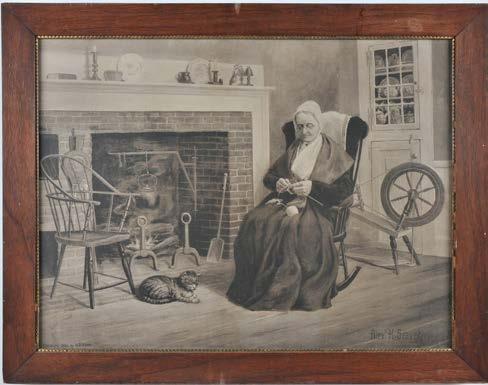
NHA.org | Nantucket Historical Association 7
Rushing to catch the steamer Nantucket, ca. 1895 Gift of Betty and Gardner MacDonald, GPN4034.
Nantucket Shore, 1865. Nantucket’s natural beauty began to attract leisure visitors in the 1840s. The painter William Trost Richards (1833–1905) captured aspects of that beauty during a summer visit just after the Civil War. Gift of the Friends of the NHA, 2019.8.1.
SUMMER ON NANTUCKET
Lydia Hussey (1798–1885) was a respected elder member of the Society of Friends. Alexander Seaverns painted Hussey in this stereotypical island interior based on photographs by Henry Wyer; Wyer then sold prints and postcards of the painting to tourists. Gift of Constance Bevivino and Jack Brown, 2012.29.1.
Nantucket’s sandy beaches, combined with its constant breezes, are the main draw of a summer visit. Historically, the beaches in and close to town were the most visited and attracted the earliest development. Peleg Macy Jr.’s bath house at South Wharf opened in 1829; E. W. Allen opened the Ocean House Bathing Rooms at the Cliff Shore (now Jetties Beach) in 1864; and Charles E. Hayden opened his long-running bathing establishment at the Clean Shore (near where Children’s Beach now is) in 1869. Except for those walkable from ’Sconset, the island’s remote beaches remained lightly visited until the 1920s due to the long wagon rides over rough roads needed to reach them. Today, nearly every beach has a name—Steps, Dionis, Cisco, Radio Tower, Nobadeer—and its devotees.
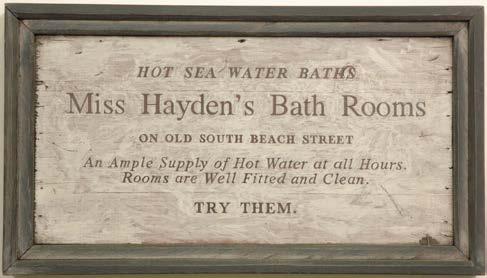
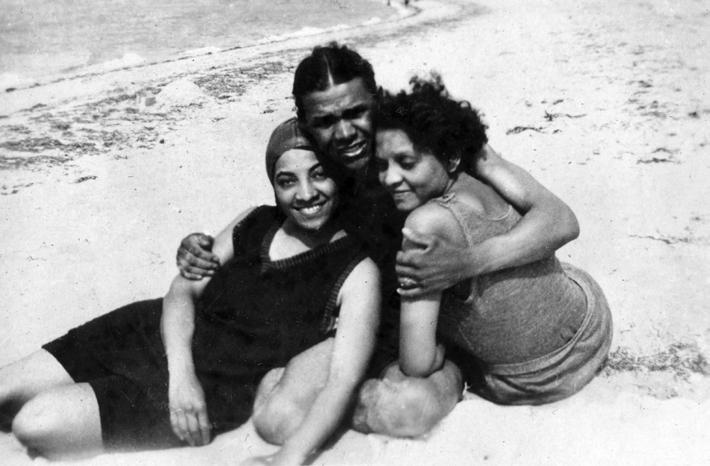
Nantucket’s open spaces, sheltered harbor, and ample shoreline have long provided appealing opportunities for recreation of all kinds. Nature walking remains as popular today as it was in the 1870s, and air-conditioned buses now cover much of the same sightseeing territory that horse-drawn carriages once offered. And each summer, Nantucket harbor and nearby waters fill with a rainbow parade of boats designed for fun and sport.
Sport fishing is a staple for visitors and locals alike. As William F. Macy noted in 1905, “A day’s bluefishing at Great Point rip is an experience no visitor with a taste piscatorial should miss . . . . Bluefishing from the beach, by the heave and haul method across the breakers, is an interesting sport when the fish are in shore.” He also noted the popularity of shark hunting off the Wauwinet shore, and fresh-water fishing in the island’s many ponds.
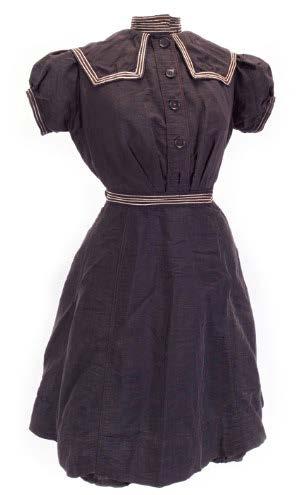
8 Historic Nantucket | Summer 2023
Above: Dave Oswell and two friends at a North Shore beach, ca. 1926. Courtesy of Isabel Stewart, SC438-11a.
Left: This woman’s bathing costume belonged to Adeline Penrose of Baltimore (1872–1950), who started summering on Nantucket with her second husband and three sons in 1908 and returned each year through 1947. Gift of Clement A. Penrose Jr. Family Trust, 2005.22.1.
SUMMER ON NANTUCKET
Sign from Miss Hayden’s Bath Rooms, ca. 1910. The Hayden family ran two bathing establishments: warm salt water baths at the Clean Shore north of Steamboat Wharf, and sea bathing and lodging at the Cliff Beach. Gift of George Korn, 2008.5.1.
WHERE TO STAY?
The collapse of whaling in the 1850s depopulated Nantucket, but the town’s unused houses converted readily to summer rentals. Off-island buyers easily purchased summer places in town or ’Sconset. As in other American resorts that grew after the Civil War, entrepreneurs developed large hotels with views of the water to entice visitors. Over 150 years, the island’s popularity as a vacation retreat has led to massive residential development all over the island, and constant pressure to build more.

Nantucket had many boarding houses and inns during its prosperous whaling days. The first two hotels marketed to summer tourists opened in town and in Siasconset in the late 1840s. Concerted efforts to advertise the island as a “watering place” in the late 1860s blossomed in a rush of hotel building in the 1870s, and the island counted eleven hotels and at least 27 rooming houses by 1884. Today most of the very large beachfront hotels of the past have been torn down and replaced by private houses, but the many intimate hotels
and inns that continue to dot the town are booked solid every year.
Nantucket’s summer home market has changed drastically over 150 years. Between about 1870 and 1920, summer home buyers largely purchased existing places in town or in ’Sconset. People wanting to summer in new, modern houses built on empty lots in town, or on the Cliff north of town, or on the perimeters of ’Sconset. Nineteenth-century efforts to develop cottage communities at Surfside, Tom Nevers, Madaket, and other remote areas failed, but these districts saw waves of new house construction after World War II. The creation of the Nantucket Historic District in 1955 restrained the exterior appearance of houses in town and ’Sconset, but elsewhere on island a variety of styles and designs proliferated until the 1970s, as people built the summer homes that best suited their tastes and needs. The expansion of the historic district to cover the entire island in 1975 has had far reaching consequences for the way summer homes look in every corner of the island.
NHA.org | Nantucket Historical Association 9
Ocean View House, ca. 1877. This small inn opened overlooking the ocean in ’Sconset 1873 and was expanded in 1876. It closed in 1917. Photograph by Josiah Freeman. GPN2664.
Above: Residential quarterboard from Fair Street. NHA purchase, 2023.8.1.
CONSTRUCTION & PRESERVATIONS
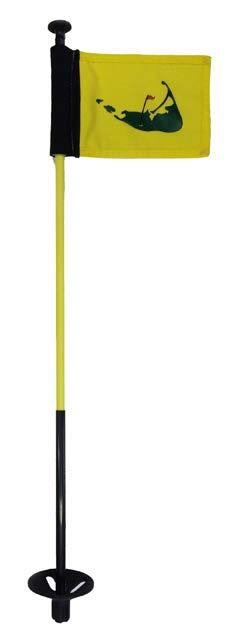
Modern Nantucket’s economy runs on real-estate sales, construction, and the many trades needed to maintain the island’s buildings. Before the hospitality industry can do its job, local tradespeople and companies provide the skilled labor needed to build and fit out new homes and businesses from foundation to chimney, while other firms specialize in the restoration and maintenance of historic buildings. So great is the demand for construction services—and so scarce is on-island housing—that the ferries bring workers from off-island throughout the fall, winter, and spring to advance island projects.
The historic feel of old Nantucket has been central to sustaining the island’s tourist economy since the nineteenth century. To preserve the island’s look, the town asked the state to create the Old Town and ’Sconset Village historic districts in 1955. Today, all of Nantucket, Tuckernuck, and Muskeget islands form a single National Landmark District, and the exterior appearance of all buildings is regulated by the elected Historic

District Commission. Nevertheless, like in many other historic coastal towns, the desire for modern and comfortable summer homes creates strong incentives to alter and replace historic buildings and viewscapes. The island’s resort success has long created immense pressure to build houses on undeveloped land. In fact, more than 76 percent of the houses standing on Nantucket today have been built since 1960. To protect open space, private citizens founded the Nantucket Conservation Foundation in 1963, and, in 1983, town meeting voted to create the Nantucket Islands Land Bank, the first land bank in the nation, where a tax on real-estate transfers funds the purchase and management of open land. These efforts have been wildly successful: 60 percent of the island is now protected from development. By limiting housing supply, however, these efforts have also contributed to a hyper-competitive real-estate market where inflated housing prices have risen beyond the reach of year-round residents and seasonal workers.
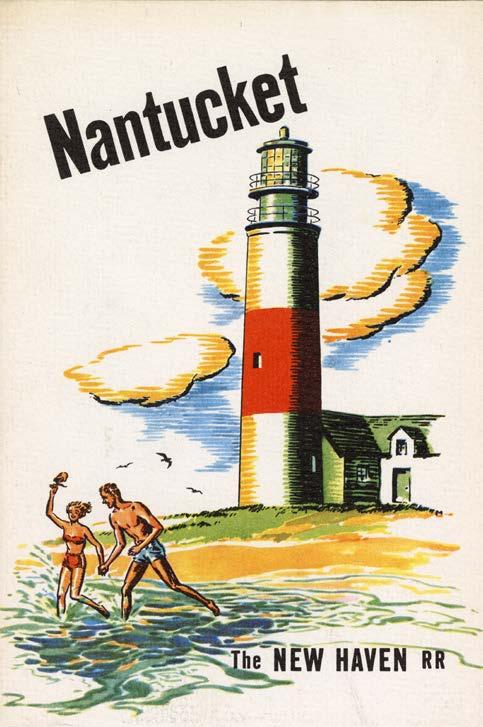
10 Historic Nantucket | Summer 2023 SUMMER ON NANTUCKET
Left: Putting-green flag from Miacomet Golf Course, 2016. Gift of Miacomet Golf Course, 2016.6.2.
Above & Right: Cover and inside map from a promotional brochure published by the New Haven Railroad, 1946. 2000.62.6.
IT’S NOT ALL ROSES
For many, summertime on Nantucket is hard work. Seasonal employees and year-round residents put extraordinary effort and long hours into making the resort work for everyone. At the same time, the resort’s runaway success has profoundly changed the island and created persistent problems, such as crowding, traffic, high prices, and a chronic shortage of affordable worker housing. For more than a century, both year-round and seasonal residents with a stake in Nantucket’s future have debated whether the island has changed too much and whether its problems can be solved, illustrating the long-term challenges of maintaining Nantucket’s resort success.
WINTER
Nantucket in winter: the crowds gone, the harbor empty, the summer homes shuttered. Yet, far from being a sleepy ghost town, the island in the off-season is alive with activity. Every renovation and refurbishment project happens in winter, all new houses are built, and every retail store is restocked. The year-round community works through the winter to prepare the island for next summer, assisted by hundreds of workers who arrive on the morning ferries, providing the labor needed to fuel the resort economy.
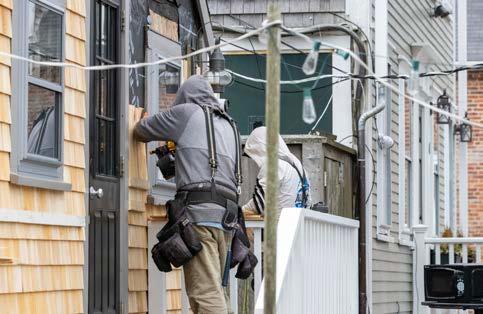
The Nantucket Historical Association gratefully acknowledges the generous support of its exhibition underwriters.

H. L. Brown Jr. Family Foundation
Robyn & John Davis
Kaaren & Charles Hale
J. Tilroe
Louise E. Turner
Nancy & Douglas Abbey
Patricia S. & Thomas J. Anathan
Lynn & Mark Filipski
Karen McLaughlin Frist
Denise & Andrew Saul
Janet & Rick Sherlund
Daisy M. Soros
Anonymous
Lindsey & Merrick Axel
Curtis L. Barnes
Tom, Cecelia & Audrey Barnes
Kay & Peter Bernon
Bessie & John Connelly
Amanda B. Cross
Kate & Kell Damsgaard
Martha Dippell & Daniel Korengold
Eileen P. Gebrian & Timothy J. Barberich
Lauren & Paul Gudonis
Diane & Art Kelly
Janet & Keith Lindgren
Susan & Jeff Lucier
Ann & Craig Muhlhauser
Susan & Scott Nelson
Anne & Edwin Obrecht
Maureen Orth
Mrs. Stanley Rand
Susan & Harry Rein
Bonnie Johnson Sacerdote
Peter C. Steingraber
Roselee & Jim Wayman
Stephanie & Jay Wilson
NHA.org | Nantucket Historical Association 11
Shingling a business in town, 2023. Photo courtesy of Bill Hoenk, photographer.

12 Historic Nantucket | Summer 2023
The locomotive Dionis and two passenger carriages at Surfside. P14585.
“For a third of a century the life line between town and Siasconset, was the dry-land complement to the steamboats - the Nantucket railroad.”
The Beginnings of the NANTUCKET
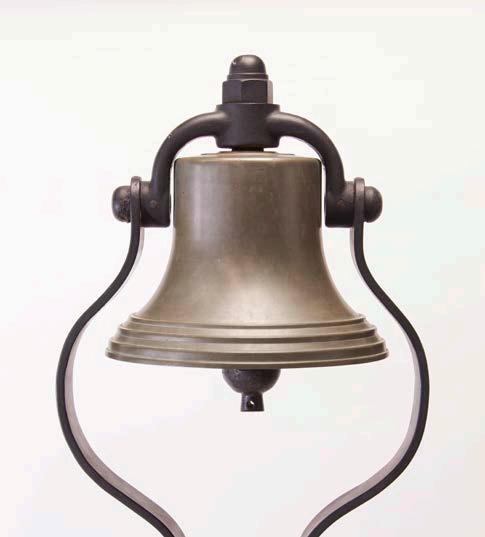
RAILROAD
 By Clay Lancaster, Architectural Historian and Author of NHA Publication, Holiday Island
By Clay Lancaster, Architectural Historian and Author of NHA Publication, Holiday Island
In 1993, the Nantucket Historical Association published Holiday Island, Clay Lancaster’s history of Nantucket’s inns and hotels from their origins during the island’s whaling era until the Great Depression. Lancaster is best remembered on island today as an architectural historian, but he was also the island’s leading expert on the Nantucket Railroad, the narrow-gauge road that connected town to the South Shore and ‘Sconset between 1881 and 1917. In this entertaining excerpt from Holiday Island, Lancaster tells the story of the railroad’s origins and outlines its place in the island’s nineteenth-century summer resort economy. [Edits for clarity are enclosed in square brackets.]
More intimately connected with summer events on Nantucket, begotten by and for land ventures, the progenitor of several hotels, and for a third of a century the life line between town and Siasconset, was the dry-land complement to the steamboats—the Nantucket railroad. Rail service to Siasconset had been proposed and a survey made during the mid-1840s by Judge Edward M. Gardner but nothing came of it. Establishing a railroad on the island was broached again in 1875, the proposed destination being Surfside. It is significant that at
NHA.org | Nantucket Historical Association 13 NANTUCKET RAILROAD
The bell from Nantucket Central Railroad engine No. 1, manufactured in 1879 and acquired for service on Nantucket in 1901. NHA purchase, 1918; exchanged to David Gray, 1955; subsequent gift of Nancy Gray in memory of David Gray, 1976. 1918.21.1 / 1976.79.1.
the time there were no civilized amenities at Surfside, and the only aspirations for a summer colony were laid out on paper. The first real evidence that a railroad might materialize was on August 12, 1879, when four civil engineers from the continent accompanied Philip H. Folger to Nantucket and began making plans for a course. They started at the Springfield House, corner of North Water and Chester streets, measured westward out Chester and West Centre (West Chester) streets to the edge of town. They continued past Maxcy’s Pond to Trott’s Hills, turned left and followed Long Pond to the south shore. Here they swung eastward; proposed crossing the crook of Hummock Pond about 300 feet from the beach, passed Miacomet Pond, Nobadeer, Madequecham, and Toupchue ponds; then they veered
route earlier described, with the exception that it was to begin at Steamboat Wharf and go out North Beach Street, omitting the Springfield House; and it was to continue from Toupchue along the shore past Tom Nevers Head and Low Beach to the base of Sunset Heights, instead of entering Siasconset via the carriage road.
Work on grading was begun in the spring of 1880. The exit from town now was via Washington Street toward the south rather than out the north end, and the western circuit was abandoned in favor of a straight drop to Surfside. The reason for the change was economic: landowners on North Beach Street asked exorbitant prices for a track strip, the price of railroad iron had gone up, entrepreneurs (at least those connected
inland to Philip’s Run and concluded along Milestone Road into Siasconset. Arthur H. Gardner, publisher and editor of the recently begun Nantucket Journal, commented that [ . . . ] “the girting of our island with an ‘iron belt’ [may] have the effect of dotting the plains with . . . cottage cities.” Here, in a phrase, was the initial motivation behind the railroad. Its circuitous route from Nantucket to Siasconset was meant to serve the Cliff, Trott’s Hills, Great Neck, Head of Plains, Smooth Hummocks, Surfside, and Sunset Heights, all of which were potential developments at that time. When Folger returned during the fall he was accompanied by Joseph Veazie, one of the promoters of Nauticon [a speculative subdivision at Great Neck]; and, although there were nine or ten backers of the railroad, Folger and Veazie alone applied for and received a right of way for the line from the Proprietors of the Common and Undivided Lands of the Island of Nantucket. The map of the proposed road drawn in the late fall mostly followed the
with the railroad venture) had decided to concentrate on Surfside, and perhaps investment in the company had not come up to expectations. [A man named] Winchester, came to the island as engineer to survey for the new route, and a contract for the work was given to Loren Downs of Boston. About half of the laborers came from America; the balance, and the teams of horses needed, were local. Grading got under way at the beginning of May. The primary problem, and the one that took longest to resolve, was building a causeway over Goose Pond. Beyond Orange Street the roadbed required a good deal of sandfill over the Clay Pits, and a cut had to be made through Michael Foley’s property. From there grade was accomplished fairly easily by men with shovels over the flat commons to the beach about 500 yards east of the life-saving station at Surfside. The work continued along the shore eastward, and by the end of June it had reached Forked Ponds,
14 Historic Nantucket | Summer 2023
“Its circuitous route from Nantucket to Siasconset was meant to serve the Cliff, Trott’s Hills, Great Neck, Head of Plains, Smooth Hummocks, Surfside, and Sunset Heights, all of which were potential developments at that time.”
about halfway to Siasconset, where it suddenly came to a halt. Work stoppage was attributed to trouble in the home office at Boston; nevertheless, the same directors were reelected in October, but it was too late in the year for the endeavor to be resumed.
In April of 1881 circulars were issued announcing proposals, affirming stability, and inviting investment in bonds of the Nantucket Railroad Company. The following month it swung into action by purchasing rails and rolling stock; and Downs brought workmen to the island and began repairing and raising the level of the roadbed. The arrival of the rails at the end of May and the use of two small flatcars on the lengthening track facilitated the work considerably. The system was narrow gauge of 36 inches. Perhaps the two most exciting moments in Nantucket’s history were in early July: the first when the engine, tender, and two cars were unloaded from the barge Roslyn Sherman on the first day of the month, and the second when they went into service, on July 4. The locomotive, a product of the Baldwin Works of Philadelphia, had been used for several months on the Danville, Olney, and Ohio River Railroad in Illinois. It was shipped to Nantucket via New York, where it was equipped with a patented spark arrester to prevent its setting fire to the pine groves; and on the flanks of the tender its name was inscribed in gold letters: “DIONIS.” The choice had been that of Charles F. Coffin, general manager of the company, and it was in memory of

Dionis Coffin, wife of the patriarch Tristram. The two passenger carriages were of the open summer style, each containing fifteen transverse benches, entered from the sides, capable of seating seventy-five to ninety persons. The cars had been employed on the Long Island Railroad and were redecorated after coming to the island. Initially, the tracks began just north of Main Street, where the station was only a part of a store, and Surfside was the end of the line. There the railroad company had a substantial depot built. It was to function as a refreshment and general recreation center, as the sea and beach were the only other attractions the area offered. [ . . . ] The building was not finished for the opening exercises, which occurred on the Glorious Fourth, but it figured prematurely in that memorable event. [ . . . ]
Nantucket summer life was focused mainly on Surfside during the next two months. The depot was completed and the name “SURF-SIDE” painted in bold letters on its roof. A well was dug, and steps were built down the embankment to the beach. The formal opening of the railroad station was on July 21, with dancing in the afternoon and evening, accompanied by violin, cornet, and piano under the direction of Prof. J. H. Backus and there were fireworks at night. Refreshments were served, and the train provided continuous service. Other events included weekly clambakes on Thursdays, which drew the older people. Monday evenings were for roller skating. [ . . . ] The south shore was so alive with activities that the Arthur Gardner newspaper declared: “Surf-side seems destined to become the ‘jumping-off place’ for tourists to Nantucket.” “Jumping-off” at Surfside precluded regrets for the tracks not now reaching Siasconset, the intended destination of the railroad. [ . . . ]
Building the railroad had removed [one of the many] obstacle[s] to the sale of cottage lots on the south shore by providing regular transportation to and from the site, and in 1882 the Surfside Land Company [established in 1873] set out to make the most of the situation. A new [subdivision of the company’s property] was created at that time, eliminating the previous fan-shaped
NHA.org | Nantucket Historical Association 15 NANTUCKET RAILROAD
Easy Street railroad tracks and locomotive garage, P5448.
“By the end of July sixty cottage lots had been sold, the number was tripled in August, and by the end of November nearly 300 units had passed into private hands....The Surfside land sales and railroad were prelude to the Surfside Hotel. The hotel was meant to justify the building of the railroad and to augment the disposal of lots.”
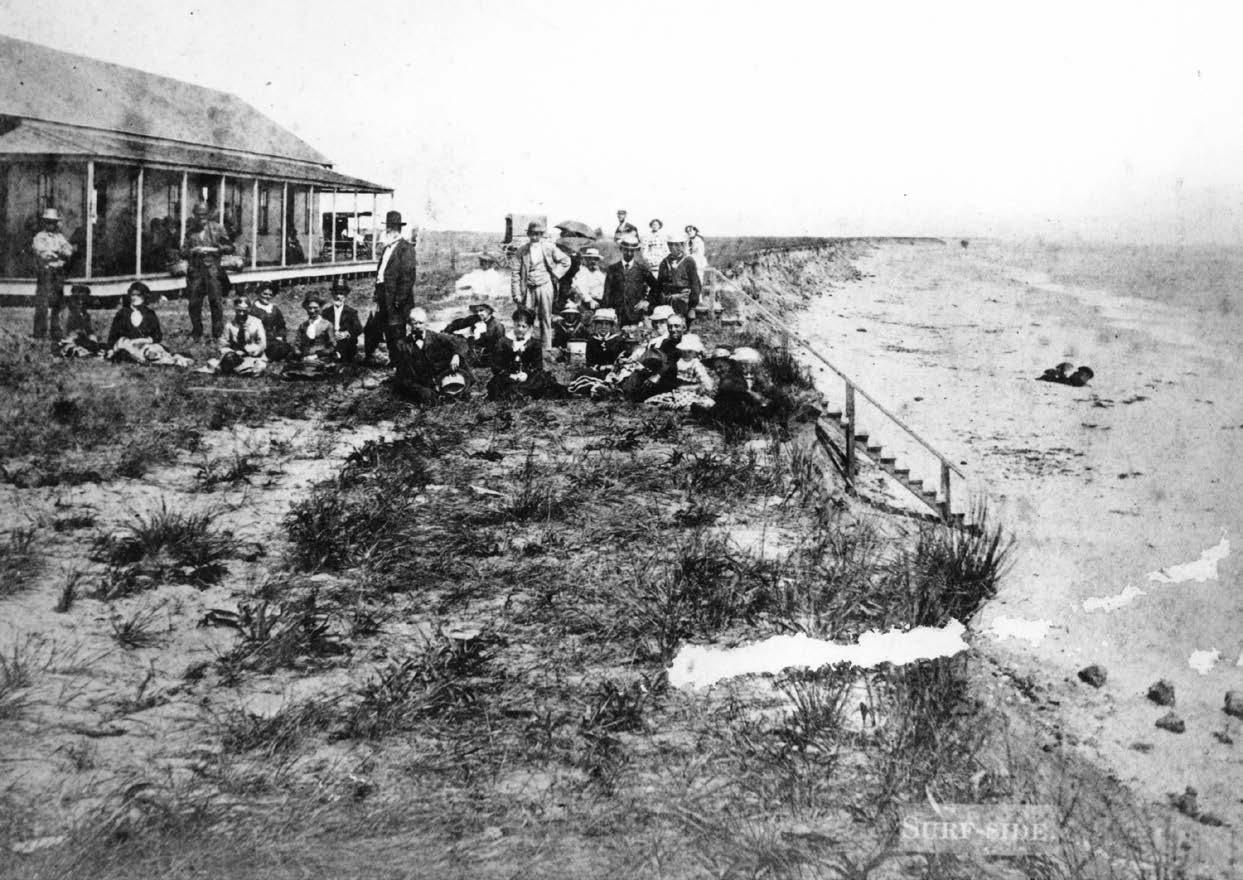
16 Historic Nantucket | Summer 2023
Sightseers at Surfside. F629.
intersections of the principal roads in favor of a regular grid, with all streets crossing at right angles. [ . . . ] The railroad tracks bordered the plan on the west and south sider and cut across the corner, below. To expedite sales, Charles F. Coffin, late general manager of the Nantucket Railroad Company (and still a director) and now treasurer of the Surfside Land Company, was given space in the station for an office. By the end of July sixty cottage lots had been sold, the number was tripled in August, and by the end of November nearly 300 units had passed into private hands [although no cottage construction resulted].
The Surfside land sales and railroad were prelude to the Surfside Hotel. The hotel was meant to justify the building of the railroad and to augment the disposal of lots. [The hotel was sited] at Nobadeer, which involved extending the tracks about a mile farther. Like the rolling stock of the train itself, the Surfside Hotel was a second-hand importation from America. It had been designed by Walker and Company of Providence, Rhode Island, and the main part of it was built as the Riverside Hotel on the Providence River. If it had been built as pictured in The Inquirer and Mirror on July 13, 1883, it would have been a sizable edifice, more than
300 feet long, consisting of a twelve-bayed main block of four stories and two-storied superstructure and twin six-bayed wings of three stories, the top floor of each unit enclosed in a mansard roof. An arched veranda was to have encompassed the main level, with deck above, and a roof loggia adjoined the crowning pent. The superstructure and wings were not realized at Riverside. The acquisition of the Riverside Hotel was announced on September 10, 1882. Within a month Charles F. Coffin was at Riverside seeing about taking down and transporting the building. Philip H. Folger was in New York to obtain road iron and flatcars to be used in lengthening the roadbed and hauling the hotel parts to the site, and the digging of the cellar had begun at Nobadeer. George Paddack of Providence, formerly of Nantucket, was engaged to disassemble the building and load the schooners for its shipment to the island. Only the twenty-six dormers were kept as units, the rest being crated and sent over as materials, which spent the better part of the winter stacked on Commercial Wharf. Around the beginning of March they were carted to the south shore and dumped in piles for sorting. Brick foundations were laid by J. S. Appleton, and construction was conducted by John S. D’Arcy of Boston. [. . . ] Toward the end there was considerable scurrying to get the building finished by the June 25 deadline.
The Surfside Hotel was a four-story block on an elevated basement measuring 40-by-125 feet. A bracketed piazza, 10-feet deep, was at the principal level and a mansard at the top. The ten-bayed facade was divided by tall, slender pilasters into five divisions, and fenestration was coupled, except for the dormer windows in the mansard roof. The name was on a quarterboard between the second- and third-story windows over the main entrance at the center. The basement contained a billiard room (40 x 50 feet) at the east end and storage rooms elsewhere. The dining hall on the first floor corresponded to the billiard room. The office, coat, and luggage rooms and the staircase were off the 24-footsquare entrance hall. The main parlor (25 x 40 feet) was at the west end, and between it and the entrance hall were two small supplementary parlors (each 12
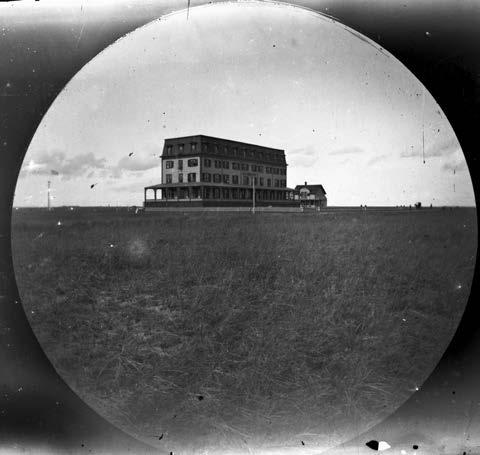
NHA.org | Nantucket Historical Association 17 NANTUCKET RAILROAD
The splendid south-shore isolation of the Surfside Hotel, ca. 1888. PH54-7.
x 15 feet) at the front and two supper rooms of equal size at the back, a passageway separating them. Each of the three chamber floors provided eighteen lodging rooms arranged to either side of a crosswise corridor, and toilets, linen room, and maids’ closets were adjacent to the stairs in the middle. The kitchen was in a separate pavilion of two stories and basement, 30-by-40 feet, set 25 feet behind the hotel proper and connected to it by an enclosed way. A laundry was below and servants’ dormitory above the “kitchen, where a Whiteley range, broilers, baker, etc., of the most approved character . . . [were] used in the culinary work.” A large pantry and dish closets were on the south side. It was noted that “water will be supplied the entire house by a steam pump and arrangements . . . completed for heating the house by steam for the comfort of such guests as may remain late in the season.” Furniture was in the Eastlake manner, of ash for the guest rooms and ebony in the parlors, upholstered in plush and silk. Included with the purchase at Riverside was an elaborate wooden fence 800 feet long which was set up on the ocean front. Charles H. Moore, formerly of the Maverick House in East Boston, was the proprietor, and the rate was $3.00 per day. [ . . . ]
In extending the tracks from the Surfside Depot to the Surfside Hotel in 1883, the railroad was one mile closer to Siasconset, its original destination. In the late fall it was announced that the railway would be continued to the village the following season. Efforts toward achieving this end became visible during March of 1884. Iron
rails and ash ties came periodically to the island until the third week in June, and a force of laborers was at work under the direction of C. M. Stansbury, grading the roadbed and laying tracks along the beach. The imminent realization of the line to Siasconset prompted the building of a new hotel at the terminus. To be precise, it was a separate pavilion to one already existing, the Ocean View House, then ten years old. Materials for the structure had been unloaded at Capt. William T. Swain’s lumber wharf in October of 1883, when it was announced that the new pavilion was to be “118 feet front, 32 feet rear and three stories high . . . [and it was to] contain, exclusive of the grand parlor, which will be 32 x 22 feet, 34 rooms, 10 on the lower floor, and 12 on each of the other two.” The placing of the building was to be “upon the rising ground at the southward of the Ocean View House and near the property of R. Gardner Chase.” To take full advantage of the ocean vista a spacious piazza was run along the entire front.” [ . . . ] Furniture for the house was ordered from Webster, Folger, and Company of Boston. Levi S. Coffin was the proprietor. Like its predecessors, the third building of the Ocean View House was designed and built by and for Charles H. Robinson. Accommodations at the complex in Siasconset were superior to those of the Surfside Hotel.
The Nantucket Railroad began passenger service [for the 1884 season] as far as Surfside on June 25, at which time the tracks had been laid to within a mile of Siasconset. The completion was achieved on July 1, and
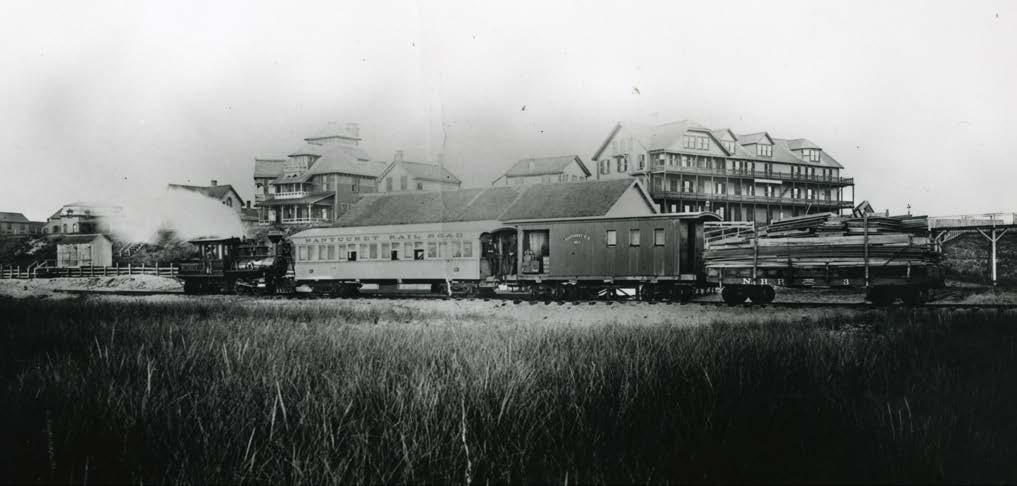
18 Historic Nantucket | Summer 2023
A train powered by the locomotive ’Sconset waits at the station in Siasconset. The Ocean View Annex looms above (at right). P10018.
ceremonies were scheduled for July 4. But between waiting for the state inspector to approve the addition to the line and for a spell of bad weather to subside, the official event had to be postponed four days. Its occurrence took place on what Nantucketers called the “Glorious Eighth.” Although the day began with dark skies that kept the timid at home, the clouds cleared away nicely; and the train, running at ninety-minute intervals, brought the largest crowd that had ever assembled at Siasconset. The tracks approached via Low Beach to the foot of the embankment under the Ocean View House. [ . . . ]
Six runs a day were scheduled between Nantucket and Siasconset, and one other went only as far as Surfside. Round-trip fare to the end of the line was 80¢ for an adult, half-price for children. To Surfside alone was 35¢ for grownups and 15¢ for juveniles. With Siasconset only twenty minutes farther away than Surfside, many of the summer functions [heretofore held at Surfside] migrated to the eastward.
In 1885 the railroad reached its zenith regarding services offered. Its road had been laid as was ever intended. Tracks at the town end had ween extended northward to Steamboat Wharf and a station built the year before. With the Surfside Hotel assuming the party functions of the Surfside Depot, half of the latter building was taken down and transferred to Siasconset to be put up as a railroad station at the terminus. The line also was to have two complete trains. Besides the Dionis with its two open cars, which was to continue on
its regular schedule, an excursion train was assembled for special occasions. It was headed by a bogie (0-4-4) engine made by the Mason Locomotive and Machine Works of Taunton, Massachusetts, and had been recently used on and leased from the Boston, Revere Beach, and Lynn Railroad. It was christened ’Sconset, and the name was inscribed in fraktur letters on the sides of the fuel compartment. A baggage car was fashioned out of one of the flatcars brought over to transport materials to the Nobadeer extension. It was a boxlike affair with a sliding door near one end of each side and three small windows at the other. With benches placed inside it could be pressed into passenger service. A second car was strictly for passengers, and it was the first piece of rolling stock purchased new for the Nantucket Railroad. Manufactured by the J. G. Brill Company of Philadelphia, it was a closed coach with sixteen upholstered seats on each side of a center aisle capable of carrying sixty-four persons. The memorable event at Siasconset during the summer of 1885 was a [a grand fireworks display. . . . ] The show was prolonged in that one of the most enjoyable parts of the evening was the return to town. The Journal described the final episode: “The fireworks lasted until 10 o’clock. With a view to the accommodation and speedy transit of its patrons, the railroad company had provided an extra train and both were in waiting to proceed to town as soon as the exhibition was over. The first train, drawn by the Dionis, was composed of the two open cars and the second was drawn by the ’Sconset and consisted of the new passenger coach and the baggage car. Both trains were comfortably filled and were run about half a mile apart, arriving in town shortly before 11 o’clock. It was a novel sight for Nantucket—two trains of lighted cars, half a mile apart, following along the shore line to Surf-side, thence across the ‘commons’ to town in the ‘dead hours of the night.’” The railroad had gained an accepted place in the summer life of Nantucket; in fact, it constituted a major attraction.

NHA.org | Nantucket Historical Association 19 NANTUCKET RAILROAD
Detail from a 1905 plat of Siasconset surveyed by J. H. Robinson. Library of Congress, Geography and Map Division.
cottage cities
that never were . . .
By Deborah Sorensen, Robyn & John Davis Curator of Exhibitions
Visions of Nantucket, now open at Hadwen House, is an exhibition of late nineteenth-century maps that were designed to promote a new type of real estate venture: the cottage city. As Nantucket’s economic engine was retooled for summer business, land speculation spread across the island. This real-estate frenzy saw fishing outposts, salt marshes, and barrier beaches reimagined as resort communities built on little more than sea views.
The cottage city craze on Nantucket can trace its origins to the island’s original speculators, the first English proprietors, and the communal ownership of the island’s common and undivided lands, which developed into a complex system of fractional shares of sheep commons. A ruling by the Massachusetts Supreme Court in 1821 enabled the exchange of grazing rights for set-off parcels of land, setting in motion a process of privatization and subdivision that accelerated as tourism on island increased after the Civil War.
Between 1870 and 1900, much of the island’s coastline was scoured by speculators—including many who were descended from Nantucket’s original proprietors. Riding waves of enthusiasm after good summer seasons, investors formed land companies, hired surveyors, and commissioned attractive plans replete with curving avenues, parkland, and thousands of waiting house lots. However, the dream they advertised masked a great gamble being made on future returns, a gamble that only occasionally paid off.1

Above: Underhill cottage at 1 Evelyn Street, ca. 1880

Unidentified photographer, GPN1641
Between 1879 and 1882, New York developer Edward Underhill built 18 summer rental cottages modeled on ’Sconset’s old fishermen’s shacks on the South Bluff.
20 Historic Nantucket | Summer 2023
1 Frances Karttunen, “What is a sheep common?” Nantucket Historical Association, nha.org, accessed May 31, 2023.
Map of Nantucket, 1874
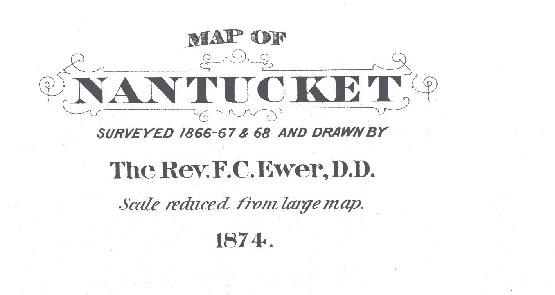

Rev. F. C. Ewer, MS1000-5-5-31
Many of the subdivisions featured in the exhibition are identified on this map, even though most were little more than open land in 1874.
“
Nantucket lands can be purchased at reasonable figures, and it is worth the while of any person who is prospecting for a place to build his summer residence, to take a run down here . . . ”
— “The Boom in Lands,” The Inquirer and Mirror, August 5, 1882
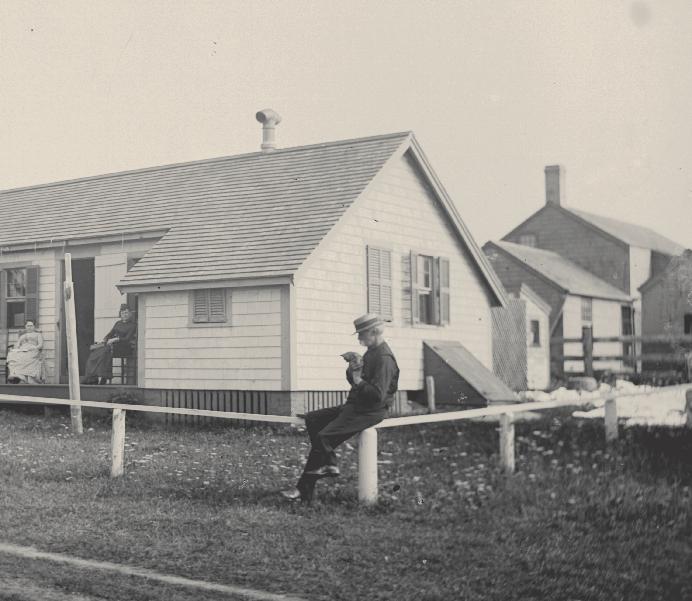
NHA.org | Nantucket Historical Association 21
Success in ’Sconset
The eighteenth-century fishing settlement at Siasconset was Nantucket’s first summer outpost and a magnet for seasonal development. The village attracted an initial wave of land speculation in 1873 and again after a new terminus for the Nantucket Railroad was established there in 1884. With the village as an attractive anchor, the surrounding area became a relatively secure location in which to invest in summer home development.
In 1873, prominent island builder Charles H. Robinson (1829–1915) and partner Dr. Franklin A. Ellis (1833–1884) established Sunset Heights (fig.1), ’Sconset’s first planned subdivision in two sheep commons at the southern edge of the village. Several of the streets laid out for this modest development are still in use, including Ocean Avenue along the coast and smaller throughways such as Grand, Laurel, and Cottage avenues.
The stereograph below (fig. 2) shows the ninety-foot-long bridge Robinson built from the end of Broadway across the south gulley to provide easy access to Sunset Heights. A model Victorian-style cottage and the Ocean View House, also built by Robinson, appear in the distance.
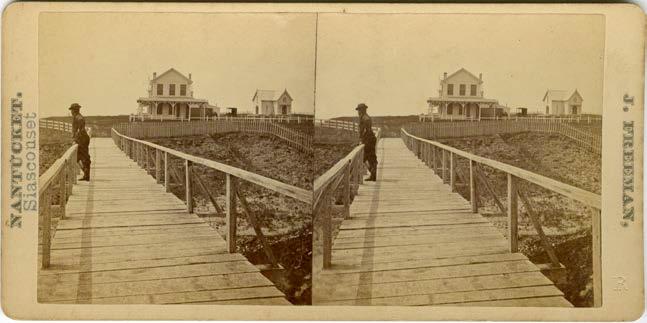
An ad promoting the sale of Sunset Heights lots for prices ranging from $100 to $250 (fig. 3) appeared. in a tourist guide published by the editor of The Island Review, Isaac H. Folger, the same year that Nantucket secured “two boats a day” summer ferry service.2

NHA
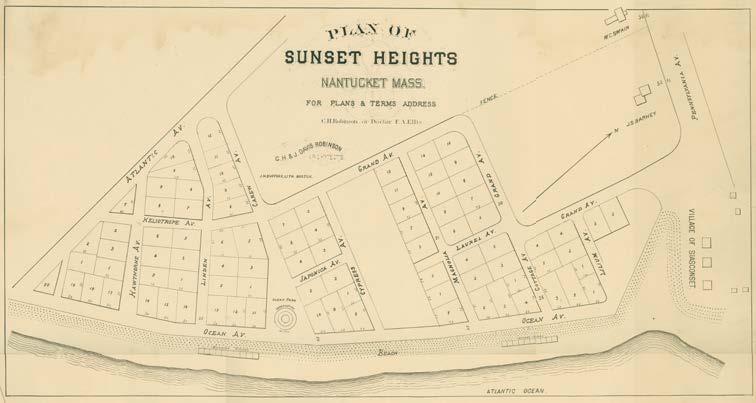
22 Historic Nantucket | Summer 2023
2 “Two Boats a Day!” The Inquirer and Mirror, Jun. 27, 1874, 3.
Figure 1. Plan of Sunset Heights, 1873.
Charles H. & J. Davis Robinson, architects; C. H. Robinson and Dr. F. A. Ellis, developers; J. H. Bufford, Boston, Mass., lithographer.
collection, MS1000-5-3-10.
Figure 2. Footbridge to Sunset Heights, 1870s.
Josiah Freeman (1840–1902), SG549.
Figure 3. Ad, “Summer Resort! Sunset Heights!” 1874.
From The Handbook of Nantucket, by Isaac H. Folger, MS397-4-53.
Stephen
Risky Ventures
Two of Nantucket’s most remote and volatile stretches of coastline caught the attention of off-island developers looking to exploit their sandy beaches and dramatic views. Plans made for the island’s western edge and the barrier beach between Nantucket Harbor and Nantucket Sound were among the most imaginative, if unrealistic, cottage city proposals put forward.
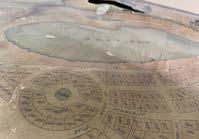
An ambitious, 1,000-acre plan for land surrounding Madaket (fig. 4) was created by Worcester architect Stephen D. Tourtellot, who received a warranty deed for the property from Captain Henry Coleman and George B. Coffin in January 1873, and visited the island several times to survey and lay out lots. His picturesque plan fills the entire tract with parkland, house lots, and avenues curving around and over waterways, including Hither, Narrow, and Further creeks (land that is now largely underwater).3

To help buyers envision the remote site’s potential, Tourtellot added illustrations of cottages and other amenities to a second plan (fig. 5). It was displayed at George F. Macy’s shop in town but failed to attract investment. News of Tourtellot’s death reached the island in fall 1873, on the heels of the disastrous Panic of 1873, and, a year later, Boston-based broker Joseph A. Veazie purchased the tract to add to his sizable island land holdings.4
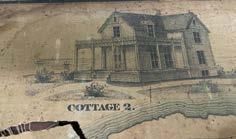
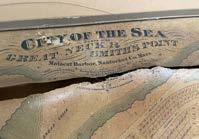
Before coming to Nantucket, Tourtellot and his apprentice-turned-partner Frank Cherrington advertised their skill with cemetery work (fig. 6). By this time, pastoral “rural” cemeteries were well-established solutions for cramped urban graveyards as well as popular outdoor recreation sites. Their aesthetic language of gated entrances, curving drives, and picturesque landscaping influenced the design of new public parks and scenic subdivisions.5

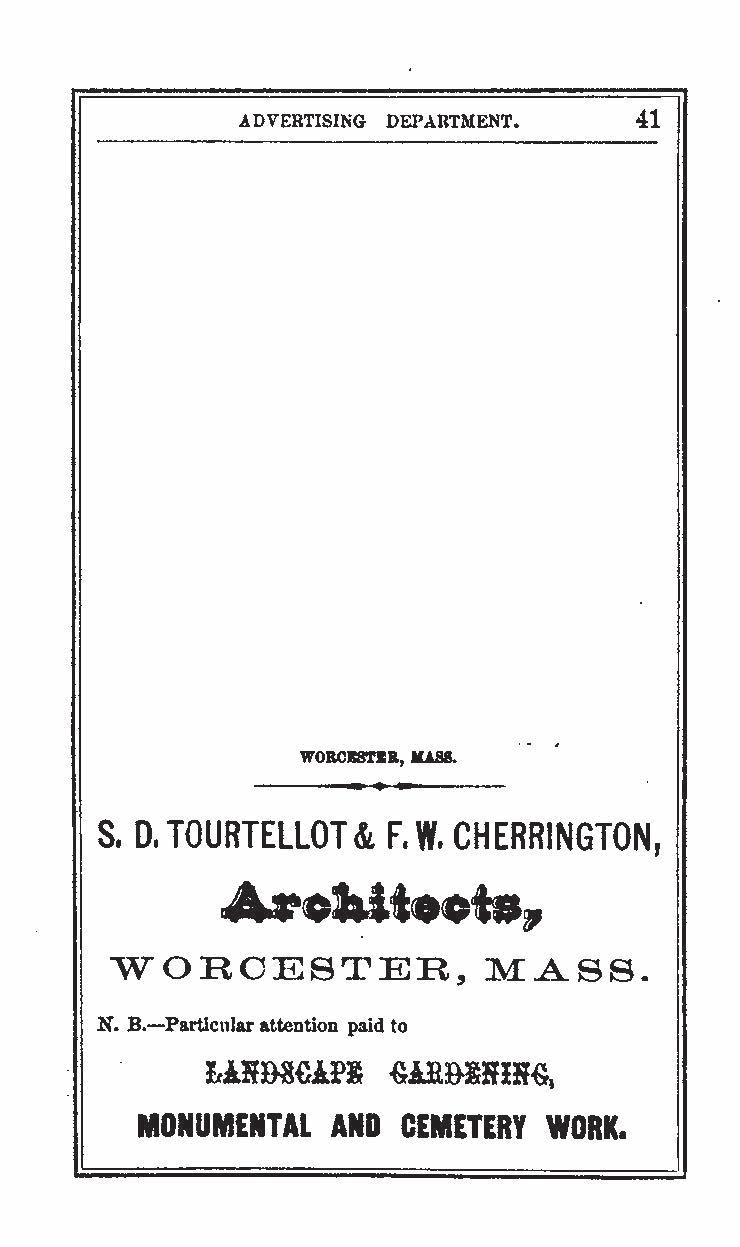
4
5 Millbury Directory: Containing the Names, Residence and Business of the Adult Population… (Worcester, MA: Tyler & Seagrave, 1871), 41; James R. Cothran and Erica Danylchak, Grave Landscapes: The Nineteenth-Century Rural Cemetery Movement (Columbia, SC: The University of South Carolina Press, 2018) pp. xiii-xiv; Marilyn Yalom, The American Resting
(Boston, MA:
NHA.org | Nantucket Historical Association 23
3 Capt. Henry Coleman Papers, MS 107; Coffin Family Papers, MS 150; The Inquirer and Mirror, Jan. 18, 1873, 2; Jun. 14, 1873, 2; Jun. 21, 1873, 2; Jul. 26, 1873, 2.
“Miscellaneous Items,” The Inquirer and Mirror, Oct. 18, 1873,2; “Great Neck,” The Inquirer and Mirror, Oct. 3, 1874, 2.
Place
Houghton Mifflin Co., 2008), pp 44-47.
Figure 4. Subdivision of Madaket, Great Neck, and Smith’s Point, ca. 1873.
Decatur Tourtellot (1815–1873), Worcester, Mass., developer; A. J. Marble, civil engineer; Cherrington & Marble, landscape gardeners. NHA collection, MS1000-5-4-12.
Right (detail): Figure 5. City of the Sea comprising Great Neck and Smith’s Point, ca. 1873. NHA collection, Gift of Miles Carlisle.
cottage cities
Figure 6. Ad, S. D. Tourtellot & Cherrington, 1871. From the Millbury Directory, Worcester, Mass.
Risky Ventures continued
The barrier beach of Coatue, between Nantucket Harbor and Nantucket Sound, was surveyed and laid out at least three times between 1883 and 1898. In 1883, the Coatue Land Company opened the Cedar Beach house with steamer service from town. It offered meals, bathing, wading, and air “free from all insects,” but struggled to survive.6
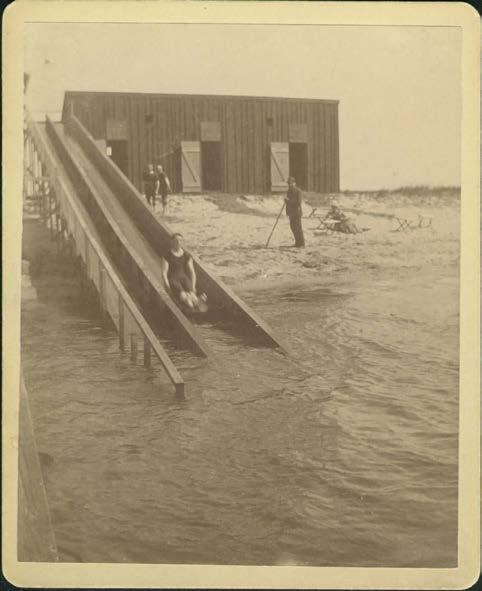
In early 1890, a syndicate of New York Businessmen purchased the land company’s holdings and laid out a new subdivision (fig. 7). The plat by Nantucketer J. B. Snow shows their plans for a hotel, stores, and summer cottages, but only a road and some bathing houses were built. Renovations made to the pre-existing Cedar Beach House (identified here as “Club House”) included the addition of swings and toboggan slides (fig. 8), but lacking the necessary land sales, the venture quickly failed. A third attempt in 1898 also foundered.7
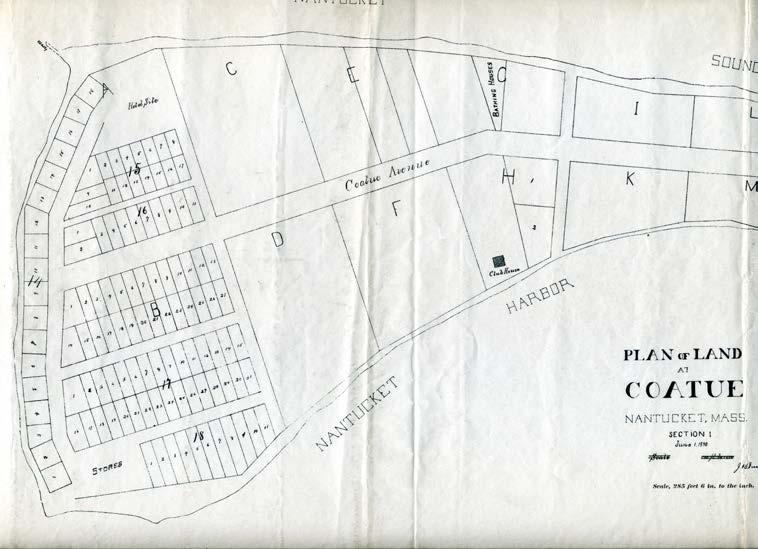
24 Historic Nantucket | Summer 2023
6 A. W. N. Small, “Cedar Beach House,” The Inquirer and Mirror, Nov. 3, 1883, 3; The Inquirer and Mirror, Jun. 21, 1890, 2; Jul. 19, 1890, 1, 4; Aug. 13, 1892, 1; Nantucket Journal, Jul. 23, 1891, 1; Jul. 13, 1893, 1.
7 “At Coatue,” Nantucket Journal, Apr. 3, 1890, 3; “Coatue to be Surveyed,” Nantucket Journal, Dec. 8, 1898, 1.
Figure 7. Plan of Land at Coatue, Nantucket, Mass., Section I, 1890.
Jesse Baker Snow (1868–1947), civil engineer. NHA collection, MS1000-6-3-1a.
Figure 8. Slide and bath houses at Coatue, 1890s. Unidentified photographer, P9647.
Safe Bets
Like Sunset Heights and Edward F. Underhill’s cottage communities on the outskirts of ’Sconset, the most successful speculative ventures were smaller developments within reach of established communities with stores, restaurants, bathing facilities, and travel connections that could be marketed alongside their empty house lots.
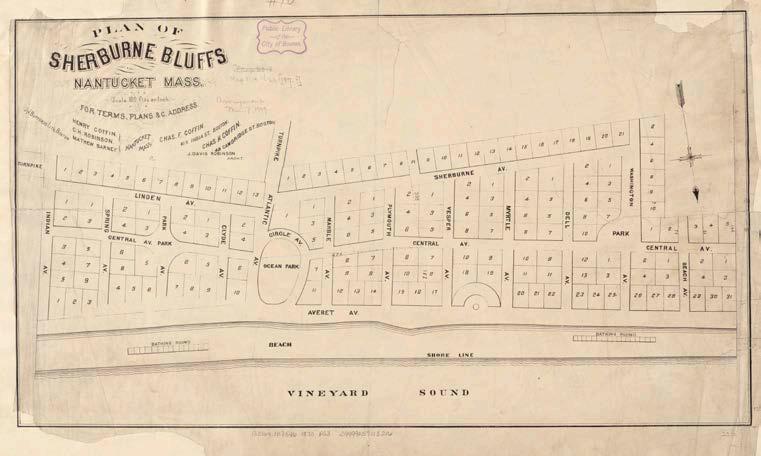
One of the island’s largest landowners, former whaling merchant Henry Coffin (1807–1900), invested in a range of cottage city developments, including the “Cliff Lots” north of town and Surfside further south. For Sherburne Bluffs, near today’s Lincoln Circle and Steps Beach, J. Davis Robinson (brother of Charles H. and co-architect for Sunset Heights, also 1873) created a plan that mirrors Sunset Heights with its tree-named streets, scenic drive along the bluff’s edge, and bathing rooms on the beach below (fig. 9).8
Lots in the Sherburne Bluffs area were purchased by notables such as painter—and enthusiastic land market participant—Eastman Johnson as well as politician Charles O’Conor, whose home “Sea Crest” and separate brick library (built 1881–82) sit on the far right in this photograph (fig. 10). Rather than make way for the plan’s scenic drive, most of the area’s estates stretched to the cliff’s edge to maximize the lots’ ocean views.9
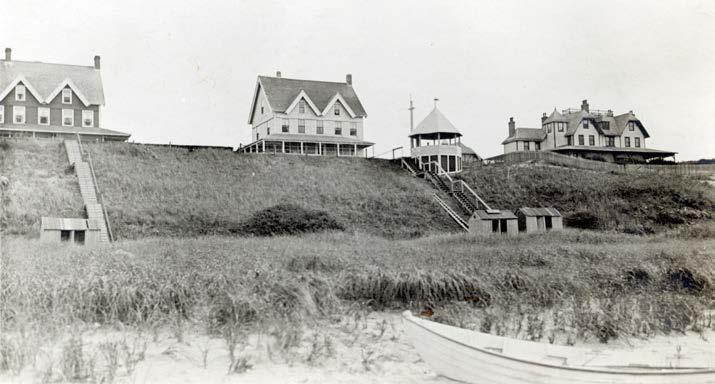
NHA.org | Nantucket Historical Association 25
8 William E. Gardner, The Coffin Saga: Nantucket’s Story, from settlement to summer visitors (Cambridge, MA: Riverside Press, 1949), pp. 270-273.
9 Ross Barrett, Speculative Landscapes: American Art and Real Estate in the Nineteenth Century (Oakland, CA: University of California Press, 2022), pp. 86–87.
Figure 9. Plan of Sherburne Bluffs, ca. 1873.
James Davis Robinson (1832–1873), architect; Henry Coffin, Charles F. Coffin, Charles H. Coffin, C. H. Robinson, and Matthew Barney, developers; J. H. Bufford, Boston, Mass., lithographer.
NHA collection, MS1000-5-4-2. Reproduction courtesy of the Norman B. Leventhal Map & Education Center at the Boston Public Library.
cottage cities
Figure 10. Three houses on the Cliff, 1900s. Unidentified photographer. Gift of Ruth C. Baltzer, SC950-1.
Safe Bets continued
One of the island’s most exclusive enclaves today, Monomoy is located east of town on the curving southern edge of Nantucket Harbor. The unusual shape of its plan (fig. 11) reflects the site’s varied topography, which has been filled in with a conventional subdivision of small cottage lots. Directional arrows along the top edge identify the distance, by water, to key locations.

One obstacle that delayed the success of the Monomoy Heights development was an area known as the Creeks, a marshy lowland that separated Monomoy’s pastures—and sweeping views—from the town beyond (fig. 12). Today, this area is home to the Creeks Preserve and enjoyed as Nantucket Land Bank parkland.
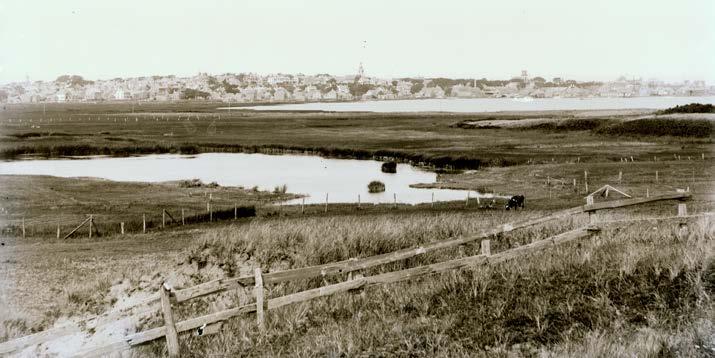
26 Historic Nantucket | Summer 2023
Figure 12. Nantucket from Monomoy, 1890s.
Henry S. Wyer (1847–1920), GPN2750.
Figure 11. Plan of Monomoy Heights, Nantucket Mass., 1889. William F. Codd (1855–1940), surveyor. Gift of Martha Riley, 2008.49.
Henry Barnard Worth, in Nantucket Lands and Land Owners (1901), commented on summer-home-driven land speculation on Nantucket at the end of the nineteenth century. “Land was quiet at Nantucket for several years until in 1880 the Island had a prosperous season, and several small tracts were developed, notably among them were Brant Point owned by E. H. Alley, Charles C. Moors, Henry Coleman, and on the hill Clifton Springs by Alfred Swain and Charles H. Robinson. Being near the town these sections were built upon at once. Then followed each year speculations in small tracts:
1882. Wauwinnet.
1883. Flagg’s lots, Siasconset.
1883. Coatue Land Co., near Wauwinnet, now on an island.
1884. Thomas Gray and Round, south of Siasconset.
1885. Sankaty Heights.
1886. Sassachacha.
What happened?
Most of the subdivision schemes seen here went no further than what was promised on paper. The timing was wrong. Locations were inaccessible, even inhospitable. Summer visitors could rent existing furnished houses and cottages or simply buy land and build for themselves, options that became even easier once the island’s automobile ban was repealed in 1918. So, while Nantucket’s proposed cottage cities failed to materialize as envisioned, the summer business they were designed to attract did come, and islanders’ enthusiastic embrace of real estate ventures has been proven spectacularly successful in the long run.
Background: House on the South Bluff of ’Sconset, ca. 1890. Unidentified photographer, GPN2519.

1886. Lincoln Heights at Cliff.
1887. Aurora Heights, Siasconset.
1888. Dionis City, west of Capaum Pond.
1889. Monomoy Heights.
1895. Low Beach, south of Siasconset.
1901. Miacomet Park.
“ . . . In general, the land ventures near the town have been successful, and also those between Wauwinnet and Low Beach. Those along the south side of the harbor on Coatue, Surfside, Hummock Pond and Madaket have been failures.” 10
10 Henry Barnard Worth, Nantucket Land and Land Owners, Nantucket Historical Association, Vol.2, Bulletin No. 1, 1901.
cottage cities
SAVE THE DATE!
Mark your calendars for a family-friendly anniversary event on Saturday, October 21 at the Oldest House. More details to come!
The Oldest House
100 Year Anniversary of the NHA’s Purchase
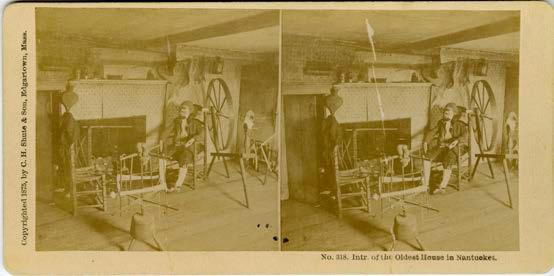
This coming October, the NHA will celebrate one hundred years since the association purchased the Oldest House on Sunset Hill.
The Oldest House, also known as the Jethro Coffin House and in the past called the Horseshoe House for the shape of the brickwork on its central chimney, is the oldest building on Nantucket still standing on its original site. It is traditionally dated to 1686 and is believed to have been a wedding present for its first occupants, Jethro and Mary (Gardner) Coffin. Like all buildings on the island then and now, it was built substantially from materials shipped from the mainland. The Coffins and their children inhabited the house for twenty years before moving away, and weaver and whaler Nathaniel Paddack bought it in 1708. It remained in the Paddack family for 131 years.
By 1867, it was uninhabited, having become inconvenient to live in by modern standards. The Turner family, which owned it, opened it to sightseers for the first time in summer 1875, attracting about seven hundred visitors, more than called at the home of Frederick Parker, “the hermit of Quidnet,” but only half as many as visited the museum at the Atheneum and less than a quarter as many as trekked out to Sankaty Head Lighthouse. Coffin family descendants purchased the house in 1881 to preserve it and began to open it regularly as a museum in 1897. The historical association bought the house in 1923 and undertook a significant restoration in 1927 in partnership with the Society for the Preservation of New England Antiquities, led by William Sumner Appleton and Alfred F. Shurrocks. The building was restored again following severe damage from lighting in 1987.
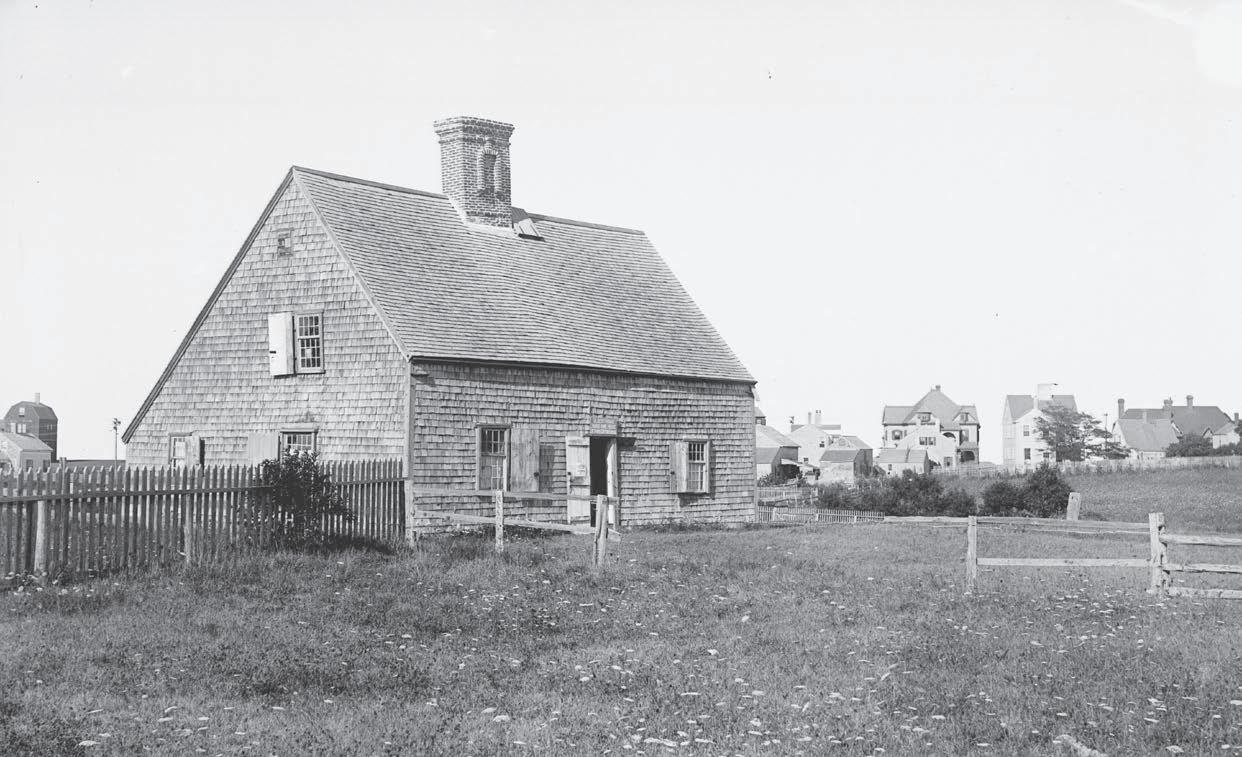
28 Historic Nantucket | Summer 2023
One of rooms in the Oldest House furnished with antiques, 1875, stereoview by C. H. Shute & Son. The earliest displays for tourists at the Oldest House mixed furniture and clothing from different centuries. SG6420.
Oldest House circa 1900, GPN2855.
MODERN BASKET MAKER

HIGHLIGHT: KATHLEEN MYERS
By Karen T. Butler
Kathleen Myers, thirty-four years a Michigan grammar school teacher, was always looking for new ways to teach her students. Her introduction to making baskets came during a graduate-level workshop in 1996 at Michigan State University, where she taught children how to make baskets using honeysuckle vine, black ash, and oak.
While attending a basket-making convention in the Midwest, Kathleen met three women who had vacationed on Nantucket and learned about lightship baskets from local weavers Nap Plank and Alan Reed. These women invited Kathleen on their next trip to the island the following year.

During this first visit to Nantucket, Kathleen contacted Karol Lindquist and Tim Parsons to receive lessons from both weavers. She made a purse basket with each of them, and each showed her their unique methods of construction and style.
Kathleen had more basket-making friends in Michigan who were fascinated by Nantucket lightship baskets and wanted to come to the island. What intrigued them was the idea that lightship baskets are not “country baskets” but an “Eastern coastal thing,” made largely in one place and using different materials and techniques from the basket traditions they knew.
Renting a house near town and recruiting six basket makers from the Midwest for those next few summers, Kathleen apprenticed to Tim Parsons while her friends joined her in learning to make Nantucket lightship baskets.
Through Tim Parsons, Kathleen eventually met Nap Plank, a maker known for his miniature lightship baskets. Nap began teaching her the tips and tricks for weaving tiny baskets. After numerous summers of diligent weaving, Nap offered her a “spot on the bench” in the shop he shared with Alan Reed. She was thrilled, as it confirmed her as a recognized lightship basket maker. Kathleen still makes her exquisite baskets today, having become an island year-round resident.
Basket nests are Kathleen’s favorite baskets to make. She has made examples with as many as eighteen baskets. The process takes a great deal of planning and care to ensure that all the details and parts work together perfectly. The result should be that each basket fits precisely inside the others, and the smallest basket is proportional to the largest one. In addition to her weaving activities, Kathleen assisted for many years in the creation of the annual exhibits at the Nantucket Lightship Basket Museum and curated the basket exhibitions at the NHA’s Hadwen House in 2021 and 2022.
NHA.org | Nantucket Historical Association 29
Programs & Events
Whaling Museum Member Exhibition Opening
This past May, we hosted a Members Exhibitions Preview Reception to celebrate the opening of our featured exhibition, Summer on Nantucket: A History of the Island Resort, in the Whaling Museum’s McCausland Gallery, as well as a special New Acquisitions exhibit in the Williams Forsyth Gallery, which includes the noteworthy, Cranberry Pickers (2023.6.1) by Eastman Johnson. During this evening celebration, we welcomed nearly 200 members and business members through the doors to enjoy these new exhibitions and kick off the summer season here at the NHA!

Modern Day Basket Makers
We were thrilled to welcome basket maker Etsuko Yashiro and a group of her students to the island to explore the history of Nantucket lightship baskets. Etsuko Yashiro, born and raised in Japan, is a trained Nantucket basket maker taught by renowned Nantucket basket-making master Alan S.W. Reed. She owns a shop and studio, GrayMist, based out of Cambridge, Massachusetts. Along with crafting baskets and sourcing fine basket products from around the world for her shop, Etsuko offers basket-making classes for students traveling all the way from Japan. In May, we welcomed her current group of students from Japan for a special tour of our current exhibition of Nantucket Lightship Baskets, now on display at Hadwen House, as well as for our members exhibition opening at the Whaling Museum. To learn more about Etsuko and her basket-making story, join us on Saturday, July 15, at 9 am for a FREE lecture at the Whaling Museum; learn more and register at NHA.org.
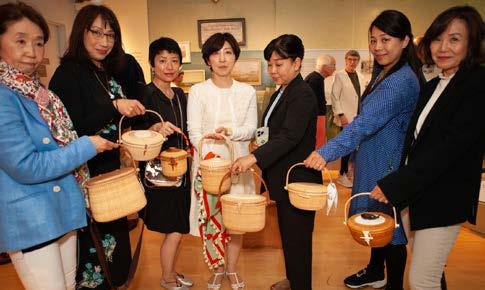
30 Historic Nantucket | Summer 2023 NEWS, NOTES & HIGHLIGHTS
Glass Demo at the 1800 House

The NHA’s Decorative Arts program offers an amazing variety of workshops throughout the year, from basket-making to blacksmithing and so much more! This season, Mary Emery Lacoursiere, NHA Peter M. and Bonnie J. Sacerdote Chair of Education and Community Relations, was thrilled to add glasswork to the array of offerings the NHA has on its calendar. To showcase this new workshop, Don Parkinson of Cape Glass held a demo at the NHA’s 1800 House to demonstrate how to use a torch to melt and manipulate glass safely and how to use different colors to create design and texture. To learn more about glasswork offerings and sign up for a workshop, visit NHA.org.
Winslow Homer and Eastman Johnson Symposium

Museum in My School
Museum in My School brings NHA artifacts and stories into the classrooms throughout the year at the Nantucket Elementary School. To wrap up the school year, our education team visited with kindergarten students with a Tony Sarg map (2010.83.1) from our collection, known for depicting the island and its many iconic scenes from the Oldest House to Sankaty Lighthouse. From this item in our collection, students were encouraged to create their own Nantucket map, adding features and drawings from their experiences growing up on the island today.
In early June, we were thrilled to host a group of museum and art scholars for a three-day symposium at our various properties to discuss Winslow Homer and Eastman Johnson’s art in preparation for a future exhibition coming to the Whaling Museum, exploring these artists’ depictions of modern American women (1865–1880). The symposium included visiting scholars from The Metropolitan Museum of Art, Philadelphia Museum of Art, Smithsonian American Art Museum, and more! Throughout the three-day symposium, scholars and NHA staff held a number of breakout sessions on varying topics from Race, Women, and Reconstruction to painting place. They also enjoyed tours of the NHA’s properties as well as a special trip out to Nantucket Conservation Foundation’s cranberry bog to observe a similar setting to Johnson’s Cranberry Pickers (2023.6.1), painting. The week ended with a program discussion, free and open to the public, with two of the scholars and NHA Chief Curator, Michael Harrison, to recap the symposium’s progress and highlights, which was recorded and is now available on the NHA’s YouTube channel.

NHA.org | Nantucket Historical Association 31
NEWS, NOTES & HIGHLIGHTS

Education
Nantucket High School Scholarship Recipients

Every year, the Nantucket Historical Association scholarships are awarded to graduating seniors of Nantucket High School pursuing a four-year college degree who have also demonstrated a commitment to Nantucket’s community through volunteer time and initiatives.
Kipper Buccino
Kipper Buccino is a Nantucket native who lives with his parents, Elizabeth and Andrew, along with his little brother Bodhi. While in high school, Kipper was involved with the Environmental Club/Youth Climate Committee and Clean Team and co-captain of the Cross-Country Running team. The Arts are also a big part of Kipper’s life. He has been involved with the Drama Club, Spring Musicals, Accidentals & Naturals Chorus, and was accepted for the AllState Music Festival 2023. He intends to study Ecology and Environmental Sciences at the University of Maine in 2023 through a lens of agriculture and equity, focusing on food access, its quality, and sustainability.
Reuben Eldridge
Reuben Eldridge is a fifth-generation Sconset native. He enjoys playing golf, lacrosse, and guitar. Reuben has been a boy scout since he was six years old and earned his Eagle rank in 2023 by completing the Sconset Park Improvement Project. Reuben is a senior at Nantucket High School and plans to attend Maine Maritime Academy in the fall to earn a Bachelor of Science in Marine Transportation Operations. This degree will prepare him for a career as a navigation officer on any size vessel on any ocean. Reuben sought a marine-related career because of his family’s rich seafaring history. He hopes to return to Nantucket after traveling the world's oceans while serving in the maritime industry.
Hunter Gross
Hunter Gross was born and raised on the island of Nantucket by his parents Karl and Nicole Gross, along with his two siblings, Emily and Chelsea. He will be attending ECAM LaSalle in Lyon, France, in the fall of 2023 to study Electrical and Mechanical Engineering. Hunter is ready to travel the world and experience new cultures starting with France. He has been a three-sport athlete at Nantucket High School, playing soccer, swimming & diving, and tennis. He is a member of the National Honor Society and enjoys playing piano in his band, Local Notes.
Gabe Zinser

Gabe Zinser was born and raised on Nantucket by his parents Jason & Regina Zinser. While attending Nantucket High School, he was part of the island’s Scouting program and earned the rank of Eagle Scout. He is an avid outdoorsman, spending his time camping and hunting during the winter. He is also a passionate musician, studying multiple instruments, including mandolin, guitar, banjo, and fiddle, and plays in multiple bands on the island. In the fall, he will be attending Belmont University in Nashville, Tennessee, as a Commercial Music Major.

32 Historic Nantucket | Summer 2023
Special thanks to the Nantucket Community Preservation Committee (CPC) for their continued support and generosity over the years.
Properties Update
Research Library Restoration Project Underway
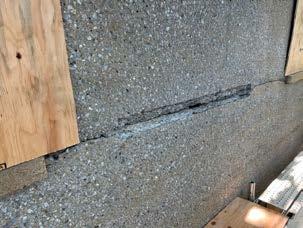
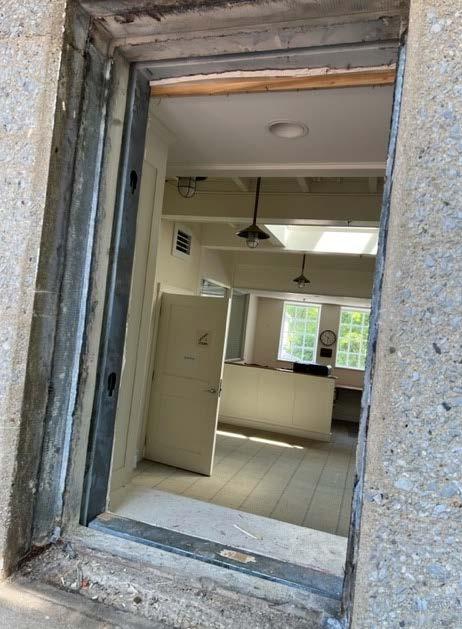
A major restoration project at the Research Library, located at 7 Fair Street, funded by the Nantucket Community Preservation Committee (CPC) is officially underway. The project includes conservation and stabilization of the historic concrete façade to ensure the building is structurally sound, as well as replacement of windows, doors, and entryway roof, installation of a new HVAC control system, fire suppression system, and water and drainage system, as well as some electrical relocation work. All while ensuring the restoration work is physically compatible with this important historic building and guaranteeing the conservation and security of the collection housed within the building.

An update from the team on the ground:
“
Our work at the Fair Street Research Library is split into two phases:
1. the South and West facades and 2. the North and East facades.
We’re well into phase one. We’ve cleaned the bio growth on the South and West, we’re finalizing color matches for our binder mixes that will be used for crack fills and patch repairs. Luckily for us, we were able to save a good amount of original aggregate from the building so we will be incorporating it into our patch repairs to best match the original look. As we finalize those mixes, we are preparing all the cracks and patches so we can begin filling them in the near future. Preparation work entails oxidation conversion treatment where any rebar is exposed and injection of the treatment where it is not. Next, we’re using injection grout in the smaller cracks and slightly opening and squaring any cracks to receive the new material best and bind with the repair.
Another part of our scope in both phases is to remove the metal window barrier that is embedded in the original window surrounds and prepare/ repair each location for the new windows to be installed. This calls for us to use a structural mortar to level out the surrounds and waterproof where the wood of the new windows meets the concrete in hopes of protecting the window from moisture uptake for as long as possible.”
Bella Boornazian, Business Administrator & Assistant Project Manager at Integrated Conservation Resources, Inc. and Integrated Conservation Contracting,
Inc.
Stay tuned for further details and updates as the project runs through the end of 2023. Throughout this closure, Research Library staff will still be responding to inquiries at library@nha.org and accommodating research appointments on a case-by-case basis. To learn more about the Research Library, please visit www.NHA.org
NHA.org | Nantucket Historical Association 33
Heather Bennett, Museum Shop Manager

I like to describe myself as “Janet of Most Trades, Master of None.” Growing up on Nantucket has given me the skills to tackle any customer service job you can think of: taxi driver, butcher, land surveyor, house painter, and insurance CSR. After trying college for a semester, I realized that I learn better by doing. I became a licensed Auto Damage Appraiser and started at the NHA in October 2021. In the beginning, I was in visitor services at the Whaling Museum and was quickly promoted to Visitor Services Assistant. While I currently still fill that role, I have since been promoted to Museum Shop Manager.
Ever since starting at the NHA, my interest in history has grown immensely, as has my love and respect for the rich history of the island. I truly appreciate all the hard work that goes into all of the NHA sites that helps us share all of this with the world.
Maranda Bouchad, Director of Marketing and Communications
As soon as Maranda discovered that crayons were for more than just eating, her passion for art was born. As a multimedia artist with a background in photography and graphic design, Maranda’s talent has taken her to New York City, where she worked in fashion and architecture photography, and back to her hometown of Bangor, where she served as the Creative Director for the Maine Discovery Museum. With a deep commitment to using her skillset for meaningful endeavors, Maranda has now embarked on a new chapter as the Director of Marketing and Communications at the Nantucket Historical Association. In her role at the NHA, Maranda brings her creative expertise to the forefront, utilizing her artistic prowess and keen eye for design to drive effective marketing campaigns and communication strategies. With a firm belief in the power of storytelling, Maranda strives to connect the rich history of Nantucket with present-day audiences, fostering a deep appreciation for the island’s cultural heritage.

34 Historic Nantucket | Summer 2023 NEWS, NOTES & HIGHLIGHTS
Meet the New Faces and Staff in New Roles at the NHA
Deven Kirby, Assistant Collections Manager


Deven is a native Texan but recently resided in Tennessee. In 2022, she graduated from the Decorative Arts and Design History master’s program at George Washington University, with a focus on Textiles and Historic Costumes. During that time, she interned at the Daughters of the American Revolution Museum. Her other schooling includes a bachelor’s degree in Art History with a minor in Anthropology and one in Studio Art with a focus on Fiber Arts from the University of North Texas. She is excited to join the NHA team after interning with the organization earlier this year.

Outgoing Trustees
NHA.org | Nantucket Historical Association 35
Carl Jelleme
Alisa A. Wood
Thank you for your years of service at the NHA!
2023 SUMMER PROGRAMS & EVENTS
JULY
Member Mornings at the Whaling Museum
Every Friday through September 1 | 9–10 am
Hands-on-History (Family Friendly)
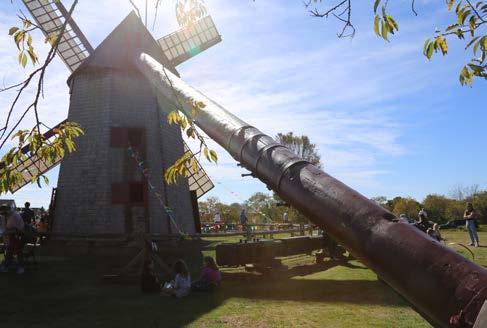
July through August (Mon–Fri) | 10 am–5 pm
Whaling Museum Discovery Center
Dec Arts: Scherenschnitte Paper Whales with Bee Shay
July 14 | 9 am–1 pm | 1800 House
Baskets & Bubbly Online Auction

July 10–17
Lecture: Baskets Beyond Nantucket with Etsuko Yashiro (FREE)
July 15 | 9–10 am | Whaling Museum
Baskets & Bubbly Celebration Under the Whale
July 16 | 5–7 pm | Whaling Museum
Dec Arts: Heirloom Teddy Bear with Anna Dean
July 19, 26, & August 2 | 9 am–12 pm 1800 House
Dec Arts: Seashell Flower Workshop with Sandi Blanda

Summer Site Series (FREE & Family Friendly)
Thursdays: July 6, 13, 20 & 27 | 11 am–3 pm
Various Historic Sites
Member Morning at Hadwen House
July 12 | 10–11 am
July 20–21 | 9 am–1 pm | 1800 House
Lecture: The Tiffany Windows at St. Paul’s Church (FREE)
July 20 | 5:30–6:30 pm | Whaling Museum
Dec Arts: Sailor’s Valentine with Sandi Blanda
July 24–26 | 9 am–1 pm | 1800 House
Dec Arts: Stitch Pin Cushion with Lucy Dillion
July 24 & 31 | 1–4 pm | 1800 House
Member Tour at Gosnold Collections Center
July 26 | 10–11 am | 89 Bartlett Road
Dec Arts: Youth Basket Weaving with Karol Lindquist (Family Friendly)
July 31–August 3 | 1–3 pm | 1800 House
36 Historic Nantucket | Summer 2023
To register and learn more about each event and program, please visit NHA.org
AUGUST
Dec Arts: Chair Caning Clinic with Liz Coffin
July 31–August 3 | 2–4 pm | 1800 House
Dec Arts: Transferware Pet Bowls with Mary Emery Lacoursiere
August 1 | 9 am–12 pm | 1800 House
Nantucket by Design: Opening Night Cocktail Party
August 2 | 6–8 pm | Private Residence
Nantucket by Design: Design Luncheon

August 3 | 11 am–1 pm | White Elephant Ballroom
Nantucket by Design: The Nantucket Summer Antiques Show Preview Party
August 3 | 5:30–8 pm | Nantucket Boys & Girls Club
Nantucket by Design: Design Panel
August 4 | 10 am–12 pm | White Elephant Ballroom
Lecture: A Living Tradition: Nantucket Lightship Baskets (FREE)
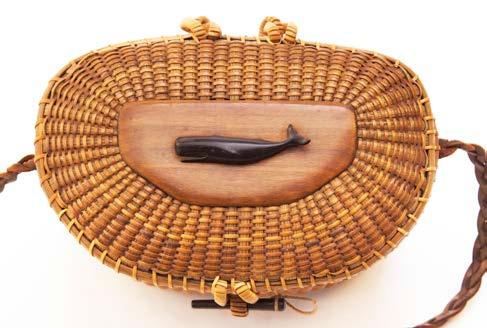
August 5 | 10 am | Nantucket Boys & Girls Club
Nantucket by Design: Closing Celebration
August 5 | 5–7 pm | Whaling Museum

Dec Arts: Boat Build, The Classic Dory with Mark Sutherland
August 8–11 | 9 am–1 pm | 1800 House
Dec Arts: Nantucket Stitch Sampler with Mary Cathryn Roth
August 8–10 | 9 am–12 pm | 1800 House
Wampanoag Day (FREE & Family Friendly)
August 10 | 11 am–3:30 pm | Children’s Beach

NHA.org | Nantucket Historical Association 37
2023 SUMMER PROGRAMS
AUGUST
Dec Arts: White Shell Garland Sailor’s Valentine with Suzanne Marie Dietsch

August 14–16 | 9 am–1 pm | 1800 House
Dec Arts: Needlework Ornament with Lucy Dillon
August 14 & 21 | 1–4 pm | 1800 House
Member Morning at Hadwen House
August 15 | 10–11 am
Dec Arts: Nantucket Rose Sailor’s Valentine with Suzanne Marie Dietsch
August 17 | 9 am–2 pm | 1800 House
Dec Arts: Pen and Ink Mirror Frame with Karen Graves
August 17 & 18 | 9 am–1 pm | 1800 House
Member Evening at Hadwen House
August 23 | 5–6 pm
Dec Arts: Botanical Printing with Bee Shay
August 28 | 9 am–1 pm | 1800 House
Moby Dick Rehearsed

August 28, 29, & 30 (3 performances) | 7 pm Whaling Museum
Dec Arts: Nature Printing with Bee Shay
August 28–31 | 9 am–1 pm | 1800 House
Dec Arts: Printing – Stencils, Stamps, and the Kitchen Sink with Bee Shay
August 29 | 9 am–1 pm | 1800 House
Dec Arts: Botanical Printing by Hand with Bee Shay
August 30 | 9 am–1 pm | 1800 House
Dec Arts: Folded Flap Journal with Bee Shay
Sea Shanties: Maritime Music Series (FREE & Family Friendly)
Thursdays: August 17, 24, 31, & September 7 | 5:30–7 pm
The Old Mill (17 & 31)
The Nantucket Shipwreck & Lifesaving Museum (24 & 7)
Dec Arts: Sailor Whirligig with Ed Brackett
August 22–25 | 9 am–1 pm | 1800 House
Dec Arts: Marble and Paste Paper with Fran Phillips

August 22 | 9 am–1 pm | 1800 House
Lecture: Sperm Whale, The Gentle Goliath of the Ocean (FREE)
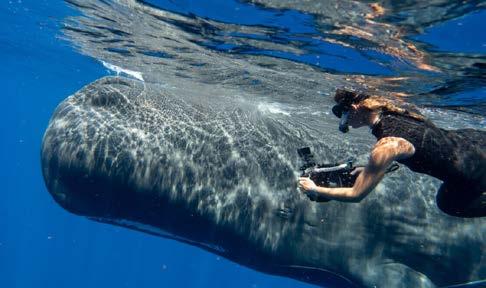
August 22 | 5:30–6:30 pm | Whaling Museum
Dec Arts: Band Boxes with Fran Phillips
August 23–24 | 9 am–1 pm | 1800 House
August 31 | 9 am–1 pm | 1800 House
Member Tour at Gosnold Collections Center
August 31 | 10–11 am | 89 Bartlett Road
38 Historic Nantucket | Spring 2023
Presents
Legacy
nantucket by design

August 2–5, 2023
As the Nantucket Historical Association’s summer fundraiser, Nantucket by Design celebrates design with engaging keynote speakers, unique discussions, a partnership with The Nantucket Summer Antiques Show, a design panel, and more!
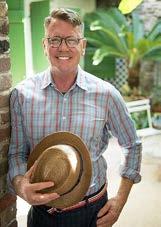

2023 Design Luminaries

Learn more and purchase tickets at NHA.org Follow us @NantucketbyDesign


 Ashley Hicks & Martina Mondadori
Steele Marcoux
Thomas Jayne Wambui Ippolito
India Hicks Nicholas Varney
Ashley Hicks & Martina Mondadori
Steele Marcoux
Thomas Jayne Wambui Ippolito
India Hicks Nicholas Varney
1894 Founders Society
Through this Society, the Board of Trustees recognizes the cumulative giving by individuals who assist with the NHA’s annual operating needs. 1894 Founders Society members contribute
$3,000 and up toward the annual fund, membership, and fundraising events, as well as to exhibitions and collections, plus scholarship and educational programs. Their generous support is greatly appreciated and welcomed by the community.
$50,000 and above
Connie & Tom Cigarran
Annabelle & Gregory Fowlkes
Jason A. Tilroe
$25,000 to $49,999
Anonymous
Nancy & Douglas Abbey
Susan Blount & Richard Bard
Amanda B. Cross
Deborah & Bruce Duncan
Barbara & Graham Goldsmith
Mark H. Gottwald
Kaaren & Charles Hale
Diane & Art Kelly
Jean Doyen de Montaillou & Michael
Kovner
Franci Neely
Ella W. Prichard
Melinda & Paul Sullivan
Kim & Finn Wentworth
$10,000 to $24,999
Elizabeth & Lee Ainslie
Janet & Sam Bailey
Mary-Randolph Ballinger
Carol & Harold Baxter
Stacey & Robert Bewkes
Patricia Nilles & C. Hunter Boll
Maureen & Edward Bousa
Anne Marie & Doug Bratton
Laurie & Bob Champion
Olivia & Felix Charney
Martha W. Cox
Robyn & John Davis
John M. DeCiccio
Tracy & John Flannery
Kelly Williams & Andrew Forsyth
Connie Anne & Jeremiah Harris
Barbara & Amos Hostetter
Susanne & Zenas Hutcheson
Cecelia Joyce Johnson
Ann & Charlie Johnson
Diane Pitt & Mitch Karlan
Jill & Stephen Karp
Frances Karttunen
Anne & Todd Knutson
Rena & Josh Kopelman
Margaret Hallowell & Stephen
Langer
Helen & Will Little
Miriam Mandell
Bonnie & Peter McCausland
Ashley & Jeff McDermott
Carla & Jack McDonald
Ashley Gosnell Mody & Darshan
Mody
Diane & Britt Newhouse
Mary & Al Novissimo
Laura & Bob Reynolds
Crystal & Rich Richardson
Denise & Andrew Saul
Helen & Chuck Schwab
Janet & Richard Sherlund
Kathleen & Robert Stansky
Harriet & Warren Stephens
Wendy & Colin Sykes
Kathryn Wagner
Paul E. Willer
Alisa & Alastair Wood
Kirsten & Peter Zaffino
$5,000 to $9,999
Patricia & Thomas Anathan
Lindsey & Merrick Axel
Victoria Sears-Bahnsen & Walter
Bahnsen
Dinah & Barry Barksdale
Carole & Gary Beller
Pamela & Max Berry
Jennifer & Jonathan Blum
Carter & Henry Boughner
Christina Lee Brown
Julie Jensen Bryan & Robert Bryan
Laura & Bill Buck
Lisa & Nathan Cressman
Beth A. Dempsey
Elizabeth Miller & James Dinan
Jennifer & Stephen Dolente
Ana & Michael Ericksen
Olamaie & Randall Fojtasek
Elizabeth Georgantas
Nan Geschke
Claire & Robert Greenspon
Gordon Gund
Catherine & Richard Herbst
Wendy Hubbell
Wendy & Randy Hudson
Joy H. Ingham
Carl Jelleme
Cynthia & Evan Jones
Mary Ann & Paul Judy
Coco & Arie Kopelman
Lucy Dillon & Kevin Kuester
Paula & Bruce Lilly
Sharon & Frank Lorenzo
Helen Lynch
Alice & J. Thomas Macy
Debra & Vincent Maffeo
Ronay & Richard Menschel
Ann & Craig Muhlhauser
Carter & Chris Norton
Liz & Jeff Peek
Maria & George Roach
Sharon & Frank Robinson
Janet L. Robinson
Linda T. Saligman
Marla & Terry Sanford
Maureen Searle
Mary Farland & Don Shockey
Georgia A. Snell
Laura & Gregory Spivy
Brooke & Michael Stanton
Kate Lubin & Glendon Sutton
Merrielou Symes
Ann & Peter Taylor
Garrett Thornburg
Sigrid & Ladd Thorne
Liz & Geoff Verney
Dorothy & Richard Verney
Suzy Welch
Mary & John West
$3,000 to $4,999
Susan D. Akers
Liz & Ben Barnes
Elizabeth Bauer
Susan & Bill Boardman
Anne DeLaney & Chip Carver
Beth K. Clyne
Beth & Andy Corry
Cynthia† & Joseph Freeman
Julie & Cam Gammill
Marybeth Gilmartin
Sara Schwartz & Will Hannum
Amy & Brett Harsch
Gloria & Jeffrey Holtman
Stephanie & Daniel Janis
Martha Dippell & Daniel Korengold
Holly & Mark Maisto
Sally & Peter† Nash
Laura & William Paulsen
Ann & Chris Quick
Margaret & John Ruttenberg
Alison & Tom Schneider
Christine & Stephen Schwarzman
Phoebe & Bobby Tudor
Denise & Bill Welsh
Harry W. Wilcox
This list represents donations from January–December 2022.
† deceased
40 Historic Nantucket | Summer 2023
To learn more or become a member of the Society, call (508) 228-1894 ext. 125 or email giving@nha.org
SHOP THE TIME TRAVELER’S EXPERIENCE!
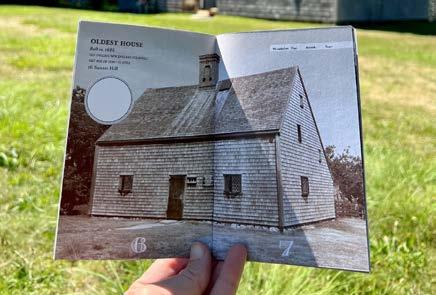
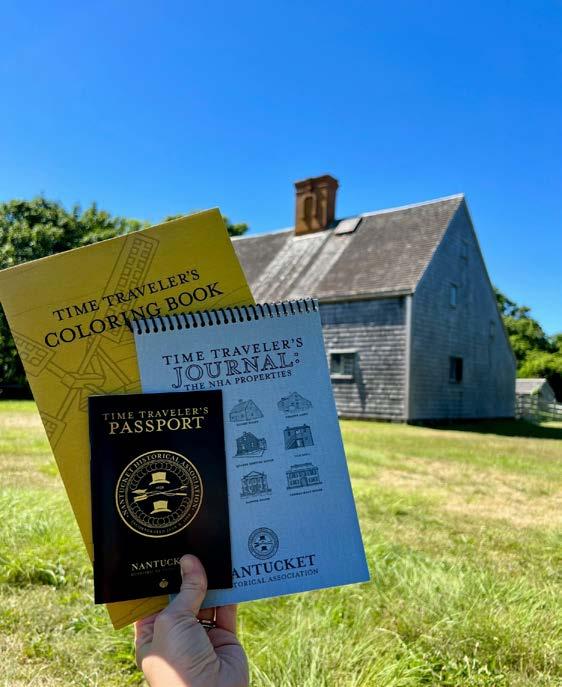
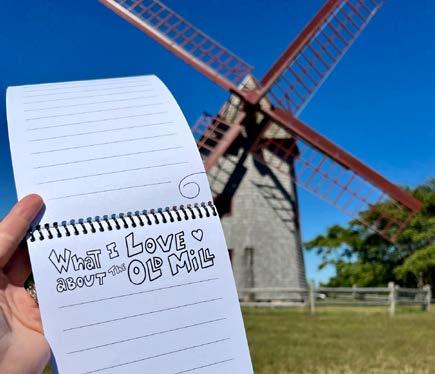
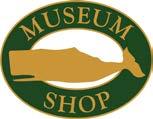
Visit the Museum Shop or order a kit online to go back in time and explore all of the NHA’s Historic Sites! This fun interactive kit includes a personalized passport to get stamped at each site, a coloring journal, and an activity book. Once a Time Traveler has their entire passport stamped, they can redeem a prize at the Whaling Museum!
The Time Traveler’s experience was created by students in the Michael Graves College at Kean University through a multi-year project partnership. Generously supported by Nancy and Douglas Abbey.
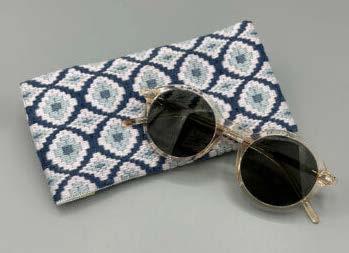

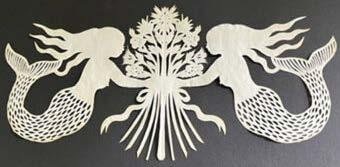


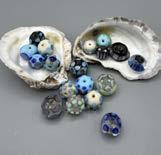



P.O. BOX 1016, NANTUCKET, MA 02554–1016 Take a Decorative Arts class to get creative and enjoy a hands-on experience, inspired by Nantucket History! SIGN UP FOR A WORKSHOP TODAY AT NHA.ORG Looking for a unique experience to do with your family and friends? Book a private workshop by emailing decarts@nha.org NHA Decorative Arts are generously supported by Non-Profit Org. U.S. Postage PAID Brockton, MA Permit # 601











 Niles Parker Gosnell Executive Director
Niles Parker Gosnell Executive Director
























 By Clay Lancaster, Architectural Historian and Author of NHA Publication, Holiday Island
By Clay Lancaster, Architectural Historian and Author of NHA Publication, Holiday Island
































































 Ashley Hicks & Martina Mondadori
Steele Marcoux
Thomas Jayne Wambui Ippolito
India Hicks Nicholas Varney
Ashley Hicks & Martina Mondadori
Steele Marcoux
Thomas Jayne Wambui Ippolito
India Hicks Nicholas Varney












